Paul van Yperen's Blog, page 406
September 21, 2014
Colin Clive
British actor Colin Clive (1900-1937) was the original Dr. Frankenstein. He made film history with his scream "It's Alive! It's Alive!" after his success at animating the Monster in Frankenstein (James Whale, 1931).
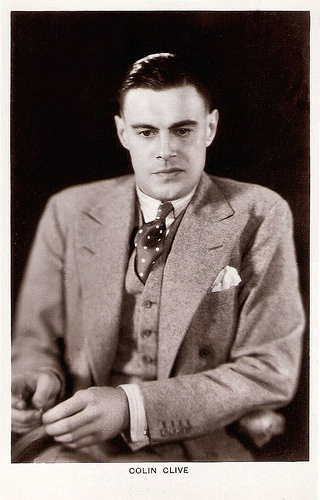 British postcard in the Picturegoer Series, no. 482, by Long Acre, London.
British postcard in the Picturegoer Series, no. 482, by Long Acre, London.
James Whale
Colin Clive was born in Saint-Malo, Ille-et-Vilaine, in 1900. He was the son of an English colonel on assignment in France at the time of Colin's birth.
Clive was a direct descendant of Baron Robert Clive, founder of the British Indian Empire. In 1935 he would appear in a featured role in Clive of India, a film biography of his relative.
He attended Royal Military Academy Sandhurst. A knee injury disqualified him from military service and contributed to his becoming a stage actor. One of his stage roles was Steve Baker, the white husband of racially mixed Julie LaVerne, in the first London production of Show Boat. This production also featured Sir Cedric Hardwicke, and Paul Robeson.
He then replaced Laurence Olivier as the lead in the R.C. Sherriff play Journey's End (1928). The success of Journey's End gave director James Whale the break to move to Broadway and to direct what would be the first British-American co-produced sound film, the film version of Journey's End (James Whale, 1930).
Whale got Colin Clive back as the laconic, alcoholic Captain Stanhope and Clive showed a measured intensity to his character, bolstered by his unique cracked baritone voice - seemingly always on the edge of irritation. This led to opportunities and he spent the rest of his career hopscotching between England and America, his most significant films emanating from Hollywood.
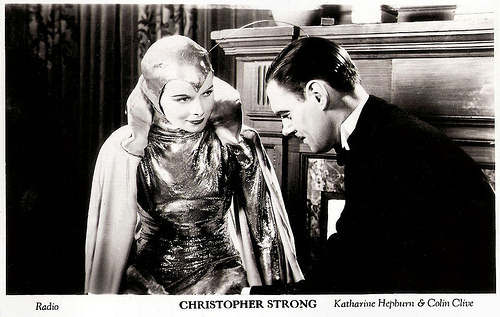 British postcard in the Filmshots series by British Weekly. Photo: Radio. Publicity still for Christopher Strong (Dorothy Arzner, 1933) with Katharine Hepburn.
British postcard in the Filmshots series by British Weekly. Photo: Radio. Publicity still for Christopher Strong (Dorothy Arzner, 1933) with Katharine Hepburn.
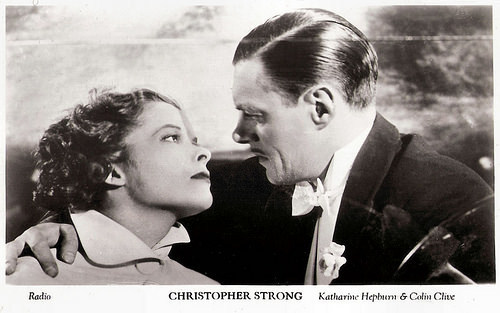 British postcard in the Filmshots series by British Weekly. Photo: Radio. Publicity still for Christopher Strong (Dorothy Arzner, 1933) with Katharine Hepburn.
British postcard in the Filmshots series by British Weekly. Photo: Radio. Publicity still for Christopher Strong (Dorothy Arzner, 1933) with Katharine Hepburn.
Dr. Henry Frankenstein
James Whale was contracted by Universal for a follow up of the huge hit Dracula (Tod Browning, 1931), an adaptation of Mary Shelley's Frankenstein. He wanted Colin Clive as Dr. Henry Frankenstein, and it all came together.
As Hal Erickson states at AllMovie : "Clive has earned a niche in cinematic valhalla for his feverish, driven performance as Dr. Frankenstein". Although Clive would make only three horror films - the others were Mad Love (Karl Freund, 1935) and Bride of Frankenstein (James Whale, 1935) - he is now widely regarded as one of the essential stars of the genre.
The following few years Clive played both B leading and A supporting roles such as the married title character in Christopher Strong (Dorothy Arzner, 1933) who falls for aviator Katherine Hepburn, the brutal husband of Diana Wynyard in One More River (James Whale, 1934), Edward Rochester in Jane Eyre (Christy Cabanne, 1934), and a British officer in Clive of India (Richard Boleslawski, 1935) in which Ronald Colman played his illustrious ancestor.
Then Clive returned to Universal for Bride of Frankenstein (James Whale, 1935) with Valerie Hobson in which his Dr. Henry was somewhat more subdued. This was mostly to do with a broken leg suffered from a horseback riding accident.
He followed Bride with Mad Love (Karl Freund, 1935), a chilling reinterpretation of The Hands of Orlac. In the remainder of his films he played disturbed supporting characters.
Privately, Clive suffered from tuberculosis, which was furthered along by severe alcoholism. His last film was The Woman I Love (Anatole Litvak, 1937) starring Miriam Hopkins.
In 1937, he died from complications of tuberculosis in Los Angeles, at age 37. From 1929 until his death, Colin Clive was married to actress Jeanne de Casalis. There has been speculation that de Casalis was a lesbian and Clive either gay or bisexual, and their marriage was one of convenience. However, producer David Lewis, the long-time companion of James Whale, flatly stated that Clive was not gay.
Scene from Frankenstein (James Whale, 1931). Source: pzmyers (YouTube).
Trailer of Bride of Frankenstein (James Whale, 1935). Source: IMACACI2 (YouTube).
Source: Hal Erickson (AllMovie), (IMDb), Wikipedia and .
 British postcard in the Picturegoer Series, no. 482, by Long Acre, London.
British postcard in the Picturegoer Series, no. 482, by Long Acre, London. James Whale
Colin Clive was born in Saint-Malo, Ille-et-Vilaine, in 1900. He was the son of an English colonel on assignment in France at the time of Colin's birth.
Clive was a direct descendant of Baron Robert Clive, founder of the British Indian Empire. In 1935 he would appear in a featured role in Clive of India, a film biography of his relative.
He attended Royal Military Academy Sandhurst. A knee injury disqualified him from military service and contributed to his becoming a stage actor. One of his stage roles was Steve Baker, the white husband of racially mixed Julie LaVerne, in the first London production of Show Boat. This production also featured Sir Cedric Hardwicke, and Paul Robeson.
He then replaced Laurence Olivier as the lead in the R.C. Sherriff play Journey's End (1928). The success of Journey's End gave director James Whale the break to move to Broadway and to direct what would be the first British-American co-produced sound film, the film version of Journey's End (James Whale, 1930).
Whale got Colin Clive back as the laconic, alcoholic Captain Stanhope and Clive showed a measured intensity to his character, bolstered by his unique cracked baritone voice - seemingly always on the edge of irritation. This led to opportunities and he spent the rest of his career hopscotching between England and America, his most significant films emanating from Hollywood.
 British postcard in the Filmshots series by British Weekly. Photo: Radio. Publicity still for Christopher Strong (Dorothy Arzner, 1933) with Katharine Hepburn.
British postcard in the Filmshots series by British Weekly. Photo: Radio. Publicity still for Christopher Strong (Dorothy Arzner, 1933) with Katharine Hepburn. British postcard in the Filmshots series by British Weekly. Photo: Radio. Publicity still for Christopher Strong (Dorothy Arzner, 1933) with Katharine Hepburn.
British postcard in the Filmshots series by British Weekly. Photo: Radio. Publicity still for Christopher Strong (Dorothy Arzner, 1933) with Katharine Hepburn.Dr. Henry Frankenstein
James Whale was contracted by Universal for a follow up of the huge hit Dracula (Tod Browning, 1931), an adaptation of Mary Shelley's Frankenstein. He wanted Colin Clive as Dr. Henry Frankenstein, and it all came together.
As Hal Erickson states at AllMovie : "Clive has earned a niche in cinematic valhalla for his feverish, driven performance as Dr. Frankenstein". Although Clive would make only three horror films - the others were Mad Love (Karl Freund, 1935) and Bride of Frankenstein (James Whale, 1935) - he is now widely regarded as one of the essential stars of the genre.
The following few years Clive played both B leading and A supporting roles such as the married title character in Christopher Strong (Dorothy Arzner, 1933) who falls for aviator Katherine Hepburn, the brutal husband of Diana Wynyard in One More River (James Whale, 1934), Edward Rochester in Jane Eyre (Christy Cabanne, 1934), and a British officer in Clive of India (Richard Boleslawski, 1935) in which Ronald Colman played his illustrious ancestor.
Then Clive returned to Universal for Bride of Frankenstein (James Whale, 1935) with Valerie Hobson in which his Dr. Henry was somewhat more subdued. This was mostly to do with a broken leg suffered from a horseback riding accident.
He followed Bride with Mad Love (Karl Freund, 1935), a chilling reinterpretation of The Hands of Orlac. In the remainder of his films he played disturbed supporting characters.
Privately, Clive suffered from tuberculosis, which was furthered along by severe alcoholism. His last film was The Woman I Love (Anatole Litvak, 1937) starring Miriam Hopkins.
In 1937, he died from complications of tuberculosis in Los Angeles, at age 37. From 1929 until his death, Colin Clive was married to actress Jeanne de Casalis. There has been speculation that de Casalis was a lesbian and Clive either gay or bisexual, and their marriage was one of convenience. However, producer David Lewis, the long-time companion of James Whale, flatly stated that Clive was not gay.
Scene from Frankenstein (James Whale, 1931). Source: pzmyers (YouTube).
Trailer of Bride of Frankenstein (James Whale, 1935). Source: IMACACI2 (YouTube).
Source: Hal Erickson (AllMovie), (IMDb), Wikipedia and .
Published on September 21, 2014 23:00
September 20, 2014
Voyna i mir (1967)
This film special is about the longest films I ever saw, Voyna i mir/War and Peace (Sergei Bondarchuk, 1965-1966). The original version even took 431 minutes. I saw a bit shorter version in the 1980s at a Dutch student festival called 'De lange zit' (The long sitting), which I helped organizing. And it was a long sitting! There were no intervals (we had simply no time for it), but plenty of free and very long films. These included Bernardo Bertolucci's Novecento/1900 (1976) and Francis Ford Coppola's The Godfather: Part 1 and II (1972-1974). But the epic film version of Tolstoy's War and Peace beat them all - in length. A happy memory.

Russian postcard by Sovexportfilm. Publicity still for Voyna i mir/War and Peace (Sergei Bondarchuk, 1965-1966). Caption: "VOINA I MIR, WAR AND PEACE, GUERRE ET PAIX, GUERRA Y PAZ". Collection: Amsterdam EYE Filmmuseum.
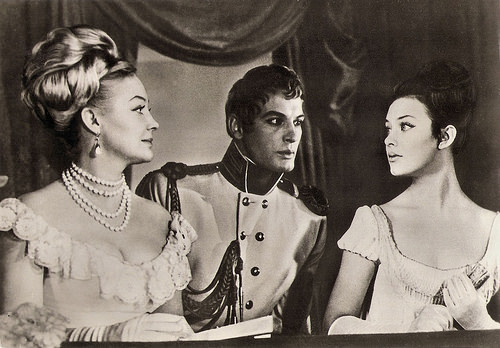
East-German postcard by VEB Progress Filmvertrieb, Berlin no. 2744, 1966. Retail price was 0,20 MDN. Photo: publicity still for Voyna i mir/War and Peace (Sergei Bondarchuk, 1965-1966) with Lyudmila Savelyeva as Natacha Rostova, Irina Skobtseva as Hélène Kuragin, and Vasili Lanovoiy as Anatol Kuragin.
The most expensive film ever made in the Soviet Union
Voyna i mir (Война́ и мир) is a Soviet film adaptation of Leo Tolstoy's novel War and Peace, released in four parts during 1966 and 1967.
Sergei Bondarchuk directed the film series, co-wrote the script and starred in the leading role of Pierre Bezukhov, alongside Vyacheslav Tikhonov and Lyudmila Savelyeva , who depicted Prince Andrei Bolkonsky and Natasha Rostova.
Voyna i mir was produced by the Mosfilm studios between 1961 and 1967, with considerable support from the authorities. At a cost of 8,291,712 Soviet ruble – equal to 9,213,013 U.S. dollar in 1967 rates, or $67 million in 2011, accounting for ruble inflation – it was the most expensive film ever made in the Soviet Union.
Upon its release, it became a success with the audiences, selling approximately 135 million tickets in its native country. Voyna i mir/War and Peace also won the Grand Prix in the Moscow International Film Festival, the Golden Globe Award for Best Foreign Language Film and the Academy Award for Best Foreign Language Film.
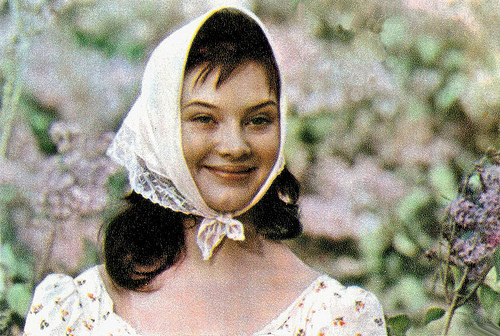
Russian postcard by Izdanije Byuro Propogandy Sovietskogo Kinoiskusstva, no. A 08343, 1969. This postcard was printed in an edition of 500,000 cards. Retail price was 6 kop. Photo: publicity still for Voyna i mir/War and Peace (Sergei Bondarchuk, 1965-1966) with Lyudmila Savelyeva .

Soviet postcard by Izdanije Byuro Propogandy Sovietskogo Kinoiskusstva, no. A 08341, 1969. This postcard was printed in an edition of 500.000 cards. Retail price: 6 Kop.Photo: publicity still for Voyna i mir/War and Peace (Sergei Bondarchuk, 1965-1966) with Sergei Bondarchuk as Pierre Bezukhov.
A counter strike to King Vidor
The nearing 150th anniversary of the 1812 French Invasion, as well the worldwide success of War and Peace (1959), King Vidor's American-Italian adaptation of the Russian national epic – at a time when the USSR and the United States were struggling for prestige – motivated the Soviet Minister of Culture Yekaterina Furtseva to begin planning a local picture based on Leo Tolstoy's novel.
An open letter which appeared in the Soviet press, signed by many of the country's filmmakers, declared: "it is a matter of honour for the Soviet cinema industry, to produce a picture which will surpass the American-Italian one in its artistic merit and authenticity." According to the German magazine Der Spiegel, the film was to serve as a 'counter strike' to King Vidor.
During 1960, several leading Soviet directors proposed themselves to head the project, but the Ministry of Culture offered it to forty-year-old Sergei Bondarchuk , who had completed his directorial debut, Destiny of a Man, in 1959.
Bondarchuk had not sought out the position and did not know of the proposal until a letter from the Ministry reached him, but he chose to accept it. He represented a generation of young directors promoted by Nikita Khruschev's Kremlin to replace the old filmmakers from the Stalin era.
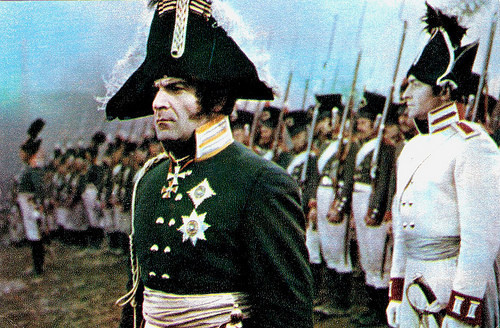
Russian postcard by Izdanije Byuro Propogandy Sovietskogo Kinoiskusstva, no. A 08352, 1969. This postcard was printed in an edition of 500,000 cards. Retail price was 6 kop. Photo: publicity still for Voyna i mir/War and Peace (Sergei Bondarchuk, 1965-1966) with Vyacheslav Tikhonov as Prince Andrei Bolkonsky. Tikhonov is the first from the right, not to be confused with the man in foreground.
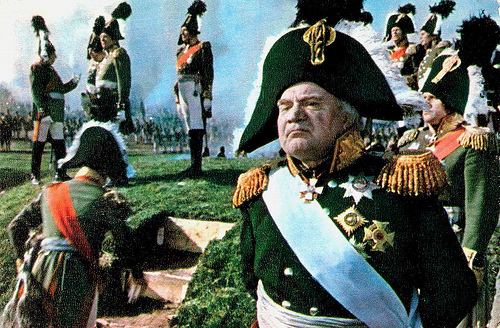
Russian postcard by Izdanije Byuro Propogandy Sovietskogo Kinoiskusstva, no. A 08359, 1969. This postcard was printed in an edition of 500.000 cards. Retail price: 6 Kop. Photo: publicity still for Voyna i mir/War and Peace (Sergei Bondarchuk, 1965-1966) with Boris Zakhava as General Kutuzov.
An authentic impression of the early 19th-century Russia
On 5 May 1961, the work on Voyna i mir/War and Peace (1967) began at the Mosfilm studios. Bondarchuk hired playwright Vasily Solovyov as his assistant for composing the script. They chose to seclude several of Tolstoy's plotlines and themes, in order not to make the film too cumbersome: the episodes concerning Nikolai Rostov and Maria Bolkonskaya were almost completely ignored, and Anatol Kuragin received an only slightly better treatment. The author's views on philosophy and history were barely mentioned at all.
On 20 March 1962, Minister Furtseva approved the scenario and requested all relevant agencies to assist the producers, including the Ministry of Defence, which was deemed central in providing support for the project.
More than forty museums contributed historical artefacts, such as chandeliers, furniture and cutlery, to create an authentic impression of the early 19th-century Russia. Thousands of costumes were sewn, mainly military uniform of the sorts worn in the Napoleonic Wars.
Anticipating the need for cavalry, line producer Nikolai Ivanov and General Osilkovsky began seeking appropriate horses. While the cavalry formations of the Army were long abolished, several units in the Transcaucasian Military District and the Turkestan Military District retained horse drawn mountain artillery. In addition to those, the Ministry of Agriculture gave away nine hundred horses and the Moscow City Police organized a detachment from its mounted regiment.
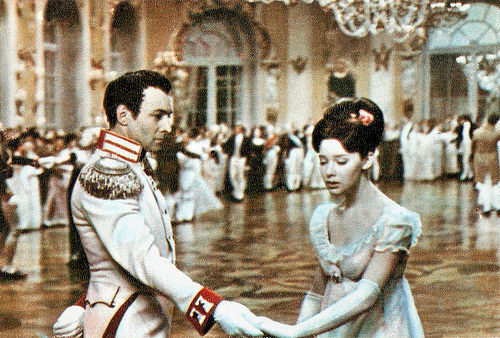
Russian postcard by Izdanije Byuro Propogandy Sovietskogo Kinoiskusstva, no. A 08356, 1969. This postcard was printed in an edition of 500,000 cards. Retail price was 6 kop. Photo: publicity still for Voyna i mir/War and Peace (Sergei Bondarchuk, 1965-1966) with Lyudmila Savelyeva and Vasili Lanovoiy.
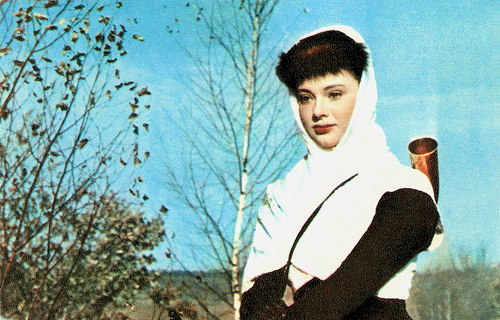
Russian postcard by Izdanije Byuro Propogandy Sovietskogo Kinoiskusstva, no. A 08339, 1969. This postcard was printed in an edition of 500,000 cards. Retail price was 6 kop. Photo: publicity still for Voyna i mir/War and Peace (Sergei Bondarchuk, 1965-1967) with Lyudmila Savelyeva .
The first Soviet picture to win the Oscar
Part I, Andrei Bolkonsky was screened in two consecutive parts, released in a total of 2,805 copies in March 1966. In the fifteen months afterwards, the first sold 58.3 million tickets in the USSR, and 58 million of the viewers remained through the intermission. Thus, Andrei Bolkonsky became the most successful film of the year.
Part II, Natasha Rostova, which opened in July with 1,405 copies disseminated, performed less well and attracted 36.2 million viewers in the same time period, reaching the third place in the 1966 box office, although it would have been ninth if counted in 1967.
The two final parts have deteriorated further: Part III, The Year 1812, with 1,407 copies released, had 21 million admissions and Part IV, Pierre Bezukhov, sold 'merely' 19.8 million tickets. They made it to the 13th and 14th place at the 1967 box office.
With a total of some 135 million tickets sold, Voyna i mir/War and Peace was considered a resounding commercial success at the time.
The series was screened in 117 countries around the world. In East Germany, the state-owned DEFA studio produced a slightly shorter edition of the series, dubbed to German, which ran 409 minutes and maintained the four-part order of the original. Among others, it featured Angelica Domröse , who voiced Lisa Bolkonskaya. It attracted more than 2 million viewers in the German Democratic Republic. In the People's Republic of Poland, it sold over 5 million tickets in 1967, and in France more than 1.2 million tickets
Walter Reade Jr.'s company Continental Distributors purchased the US rights of Voyna i mir/War and Peace for $1.5 million. The distributor shortened the American version by an hour, and added English-language dubbing.
In July 1965, Voyna i mir/War and Peace was awarded the Grand Prix at the 4th Moscow International Film Festival together with the Hungarian entry Húsz óra Twenty Hours (Zoltán Fábri, 1965). In 1967, Voyna i mir was entered into the 1967 Cannes Film Festival, outside of the competition.
In the United States, it won the Golden Globe Award for Best Foreign Language Film in the 26th Golden Globe Awards. The picture was the Soviet entry to the 41st Academy Awards. It received the Academy Award for Best Foreign Language Film and was nominated for the Academy Award for Best Art Direction. Voyna i mir/War and Peace was the first Soviet picture to win the Oscar for best foreign film, and also the longest film ever to receive an Academy Award.
In 1986, Sergei Bondarchuk was requested to prepare Voyna i mir/War and Peace for a broadcast in television. A 35-mm. copy of the series, which was filmed in parallel to the main version and had a 4:3 aspect ratio, rather than the 70-mm. 2.20:1, was submitted, after being adapted by a team headed by Petritsky.
In 1999, as part of an initiative to restore its old classics, Mosfilm resolved to restore Voyna i mir/War and Peace. As the original 70-mm. reels were damaged beyond repair, the studio used the 1988 4:3 version and the original soundtrack to make a DVD edition.

Russian postcard by Izdanije Byuro Propogandy Sovietskogo Kinoiskusstva, no. A 08351, 1969. This postcard was printed in an edition of 500,000 cards. Retail price was 6 kop. Photo: publicity still for Voyna i mir/War and Peace (Sergei Bondarchuk, 1965-1966) with Lyudmila Savelyeva .
Sources: Wikipedia and IMDb.

Russian postcard by Sovexportfilm. Publicity still for Voyna i mir/War and Peace (Sergei Bondarchuk, 1965-1966). Caption: "VOINA I MIR, WAR AND PEACE, GUERRE ET PAIX, GUERRA Y PAZ". Collection: Amsterdam EYE Filmmuseum.

East-German postcard by VEB Progress Filmvertrieb, Berlin no. 2744, 1966. Retail price was 0,20 MDN. Photo: publicity still for Voyna i mir/War and Peace (Sergei Bondarchuk, 1965-1966) with Lyudmila Savelyeva as Natacha Rostova, Irina Skobtseva as Hélène Kuragin, and Vasili Lanovoiy as Anatol Kuragin.
The most expensive film ever made in the Soviet Union
Voyna i mir (Война́ и мир) is a Soviet film adaptation of Leo Tolstoy's novel War and Peace, released in four parts during 1966 and 1967.
Sergei Bondarchuk directed the film series, co-wrote the script and starred in the leading role of Pierre Bezukhov, alongside Vyacheslav Tikhonov and Lyudmila Savelyeva , who depicted Prince Andrei Bolkonsky and Natasha Rostova.
Voyna i mir was produced by the Mosfilm studios between 1961 and 1967, with considerable support from the authorities. At a cost of 8,291,712 Soviet ruble – equal to 9,213,013 U.S. dollar in 1967 rates, or $67 million in 2011, accounting for ruble inflation – it was the most expensive film ever made in the Soviet Union.
Upon its release, it became a success with the audiences, selling approximately 135 million tickets in its native country. Voyna i mir/War and Peace also won the Grand Prix in the Moscow International Film Festival, the Golden Globe Award for Best Foreign Language Film and the Academy Award for Best Foreign Language Film.

Russian postcard by Izdanije Byuro Propogandy Sovietskogo Kinoiskusstva, no. A 08343, 1969. This postcard was printed in an edition of 500,000 cards. Retail price was 6 kop. Photo: publicity still for Voyna i mir/War and Peace (Sergei Bondarchuk, 1965-1966) with Lyudmila Savelyeva .

Soviet postcard by Izdanije Byuro Propogandy Sovietskogo Kinoiskusstva, no. A 08341, 1969. This postcard was printed in an edition of 500.000 cards. Retail price: 6 Kop.Photo: publicity still for Voyna i mir/War and Peace (Sergei Bondarchuk, 1965-1966) with Sergei Bondarchuk as Pierre Bezukhov.
A counter strike to King Vidor
The nearing 150th anniversary of the 1812 French Invasion, as well the worldwide success of War and Peace (1959), King Vidor's American-Italian adaptation of the Russian national epic – at a time when the USSR and the United States were struggling for prestige – motivated the Soviet Minister of Culture Yekaterina Furtseva to begin planning a local picture based on Leo Tolstoy's novel.
An open letter which appeared in the Soviet press, signed by many of the country's filmmakers, declared: "it is a matter of honour for the Soviet cinema industry, to produce a picture which will surpass the American-Italian one in its artistic merit and authenticity." According to the German magazine Der Spiegel, the film was to serve as a 'counter strike' to King Vidor.
During 1960, several leading Soviet directors proposed themselves to head the project, but the Ministry of Culture offered it to forty-year-old Sergei Bondarchuk , who had completed his directorial debut, Destiny of a Man, in 1959.
Bondarchuk had not sought out the position and did not know of the proposal until a letter from the Ministry reached him, but he chose to accept it. He represented a generation of young directors promoted by Nikita Khruschev's Kremlin to replace the old filmmakers from the Stalin era.

Russian postcard by Izdanije Byuro Propogandy Sovietskogo Kinoiskusstva, no. A 08352, 1969. This postcard was printed in an edition of 500,000 cards. Retail price was 6 kop. Photo: publicity still for Voyna i mir/War and Peace (Sergei Bondarchuk, 1965-1966) with Vyacheslav Tikhonov as Prince Andrei Bolkonsky. Tikhonov is the first from the right, not to be confused with the man in foreground.

Russian postcard by Izdanije Byuro Propogandy Sovietskogo Kinoiskusstva, no. A 08359, 1969. This postcard was printed in an edition of 500.000 cards. Retail price: 6 Kop. Photo: publicity still for Voyna i mir/War and Peace (Sergei Bondarchuk, 1965-1966) with Boris Zakhava as General Kutuzov.
An authentic impression of the early 19th-century Russia
On 5 May 1961, the work on Voyna i mir/War and Peace (1967) began at the Mosfilm studios. Bondarchuk hired playwright Vasily Solovyov as his assistant for composing the script. They chose to seclude several of Tolstoy's plotlines and themes, in order not to make the film too cumbersome: the episodes concerning Nikolai Rostov and Maria Bolkonskaya were almost completely ignored, and Anatol Kuragin received an only slightly better treatment. The author's views on philosophy and history were barely mentioned at all.
On 20 March 1962, Minister Furtseva approved the scenario and requested all relevant agencies to assist the producers, including the Ministry of Defence, which was deemed central in providing support for the project.
More than forty museums contributed historical artefacts, such as chandeliers, furniture and cutlery, to create an authentic impression of the early 19th-century Russia. Thousands of costumes were sewn, mainly military uniform of the sorts worn in the Napoleonic Wars.
Anticipating the need for cavalry, line producer Nikolai Ivanov and General Osilkovsky began seeking appropriate horses. While the cavalry formations of the Army were long abolished, several units in the Transcaucasian Military District and the Turkestan Military District retained horse drawn mountain artillery. In addition to those, the Ministry of Agriculture gave away nine hundred horses and the Moscow City Police organized a detachment from its mounted regiment.

Russian postcard by Izdanije Byuro Propogandy Sovietskogo Kinoiskusstva, no. A 08356, 1969. This postcard was printed in an edition of 500,000 cards. Retail price was 6 kop. Photo: publicity still for Voyna i mir/War and Peace (Sergei Bondarchuk, 1965-1966) with Lyudmila Savelyeva and Vasili Lanovoiy.

Russian postcard by Izdanije Byuro Propogandy Sovietskogo Kinoiskusstva, no. A 08339, 1969. This postcard was printed in an edition of 500,000 cards. Retail price was 6 kop. Photo: publicity still for Voyna i mir/War and Peace (Sergei Bondarchuk, 1965-1967) with Lyudmila Savelyeva .
The first Soviet picture to win the Oscar
Part I, Andrei Bolkonsky was screened in two consecutive parts, released in a total of 2,805 copies in March 1966. In the fifteen months afterwards, the first sold 58.3 million tickets in the USSR, and 58 million of the viewers remained through the intermission. Thus, Andrei Bolkonsky became the most successful film of the year.
Part II, Natasha Rostova, which opened in July with 1,405 copies disseminated, performed less well and attracted 36.2 million viewers in the same time period, reaching the third place in the 1966 box office, although it would have been ninth if counted in 1967.
The two final parts have deteriorated further: Part III, The Year 1812, with 1,407 copies released, had 21 million admissions and Part IV, Pierre Bezukhov, sold 'merely' 19.8 million tickets. They made it to the 13th and 14th place at the 1967 box office.
With a total of some 135 million tickets sold, Voyna i mir/War and Peace was considered a resounding commercial success at the time.
The series was screened in 117 countries around the world. In East Germany, the state-owned DEFA studio produced a slightly shorter edition of the series, dubbed to German, which ran 409 minutes and maintained the four-part order of the original. Among others, it featured Angelica Domröse , who voiced Lisa Bolkonskaya. It attracted more than 2 million viewers in the German Democratic Republic. In the People's Republic of Poland, it sold over 5 million tickets in 1967, and in France more than 1.2 million tickets
Walter Reade Jr.'s company Continental Distributors purchased the US rights of Voyna i mir/War and Peace for $1.5 million. The distributor shortened the American version by an hour, and added English-language dubbing.
In July 1965, Voyna i mir/War and Peace was awarded the Grand Prix at the 4th Moscow International Film Festival together with the Hungarian entry Húsz óra Twenty Hours (Zoltán Fábri, 1965). In 1967, Voyna i mir was entered into the 1967 Cannes Film Festival, outside of the competition.
In the United States, it won the Golden Globe Award for Best Foreign Language Film in the 26th Golden Globe Awards. The picture was the Soviet entry to the 41st Academy Awards. It received the Academy Award for Best Foreign Language Film and was nominated for the Academy Award for Best Art Direction. Voyna i mir/War and Peace was the first Soviet picture to win the Oscar for best foreign film, and also the longest film ever to receive an Academy Award.
In 1986, Sergei Bondarchuk was requested to prepare Voyna i mir/War and Peace for a broadcast in television. A 35-mm. copy of the series, which was filmed in parallel to the main version and had a 4:3 aspect ratio, rather than the 70-mm. 2.20:1, was submitted, after being adapted by a team headed by Petritsky.
In 1999, as part of an initiative to restore its old classics, Mosfilm resolved to restore Voyna i mir/War and Peace. As the original 70-mm. reels were damaged beyond repair, the studio used the 1988 4:3 version and the original soundtrack to make a DVD edition.

Russian postcard by Izdanije Byuro Propogandy Sovietskogo Kinoiskusstva, no. A 08351, 1969. This postcard was printed in an edition of 500,000 cards. Retail price was 6 kop. Photo: publicity still for Voyna i mir/War and Peace (Sergei Bondarchuk, 1965-1966) with Lyudmila Savelyeva .
Sources: Wikipedia and IMDb.
Published on September 20, 2014 23:00
September 19, 2014
Happy 80, Sophia Loren!
Today it's the 80th birthday of bellissima Sophia Loren! Sofia Villani Scicolone was born at the Clinica Regina Margherita in Rome on 20 September 1934. La Loren rose to fame in post-war Italy as a voluptuous sex goddess. Soon after she became one of the most successful international stars of the 20th Century. As a salute, a post with 20 of our favourite postcards of this Academy Award-winning and super European film star!
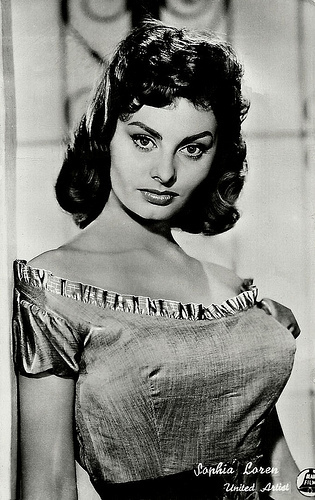
Belgian postcard by Bromophoto, Brussels.
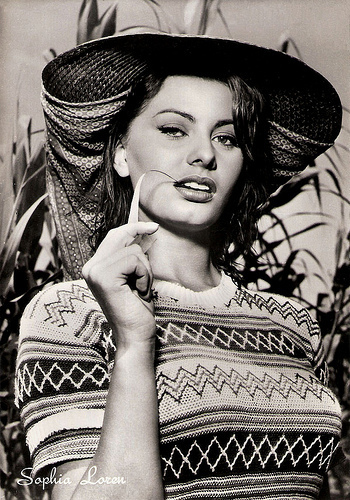
Italian postcard by Rotalfoto, Milano, no. 328. Photo: Ponti-De Laurentiis. Publicity still for La donna del fiume/Woman of the River (Mario Soldati, 1954).
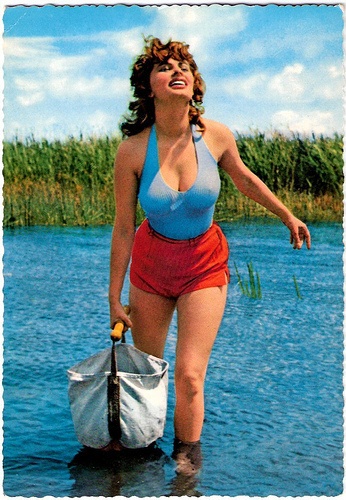
German postcard printed by Krüger, no. 902/304. Photo: Georg Michalke. Publicity still for La donna del fiume/Woman of the River (Mario Soldati, 1954).
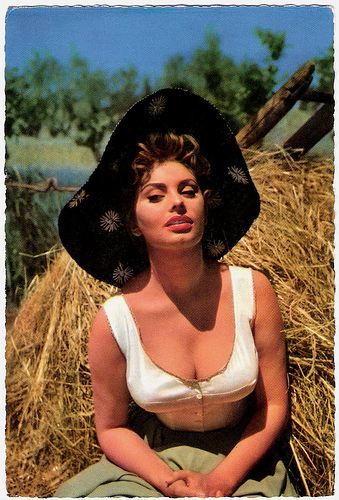
German postcard by UFA, no. 1007. Photo: UFA. Publicity still for La Bella Mugnaia/The Miller's Wife (Mario Camerini, 1955).
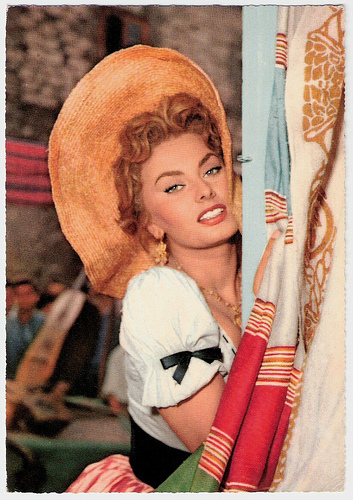
German postcard by Krüger, no. 902/446. Photo: Ufa.
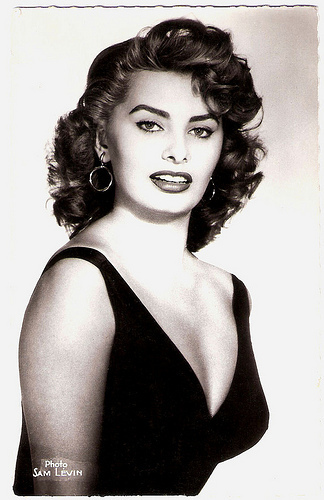
French postcard by Editions du Globe (EDUG), Paris, no. 373. Photo: Sam Lévin.
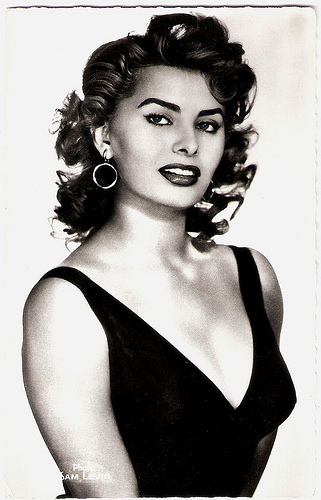
French postcard by Edition du Globe, Paris, no. 374. Photo: Sam Lévin.
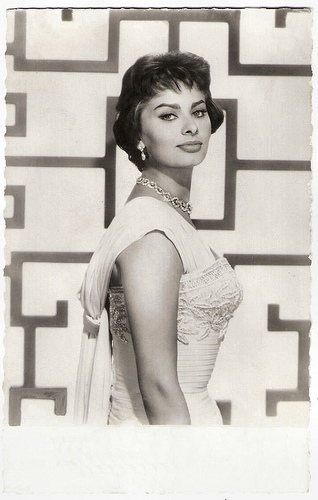
French postcard by Editions P.I., Paris, no. 946. Photo: Paramount Pictures, 1957.
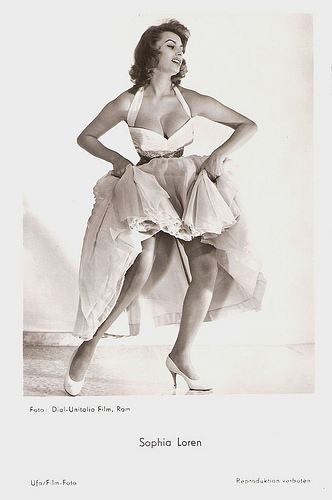
German postcard by Universum-Film Aktiengesellschaft, Berlin-Tempelhof, no. 1631. Photo: Dial / Unitalia Film, Rome.
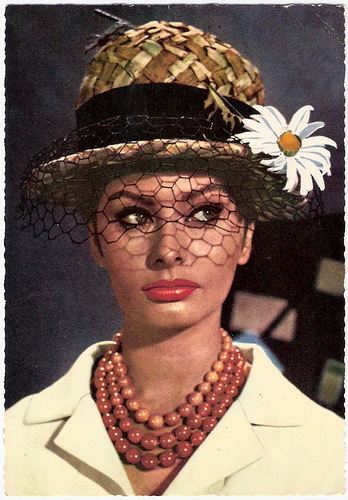
German postcard by ISV, no. A 93. Photo: 20th Century Fox. Publicity still for the British film The Millionairess (Anthony Asquith, 1960).
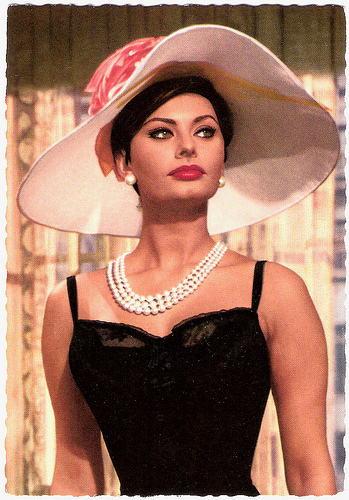
German postcard by Filmbilder-Vertrieb Ernst Freihoff, Essen, no. A 102. Photo: 20th Century Fox. Publicity still for The Millionairess (Anthony Asquith, 1960).

Dutch postcard. Photo: publicity still for El Cid (Anthony Mann, 1961).
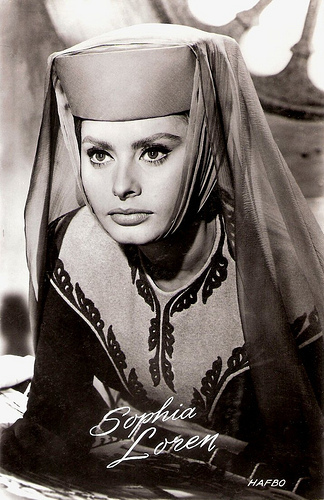
Dutch postcard by Uitg. Takken, Utrecht, no. 4894. Photo: Hafbo. Publicity still for El Cid (Anthony Mann, 1961).
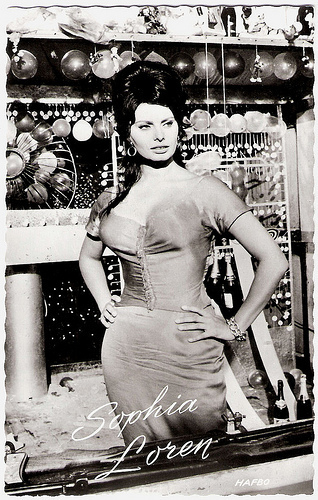
German postcard by Filmbilder-Vertrieb Ernst Freihoff, Essen, no. 5096. Photo: publicity still for Boccaccio '70 (Vittorio De Sica, 1962).
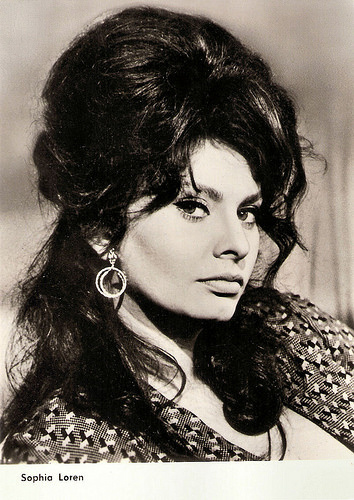
East-German card by VEB Progress Film-Vertrieb, Berlin, no. 2372, 1965. Photo: publicity still for Boccaccio '70 (Vittorio De Sica a.o., 1962).
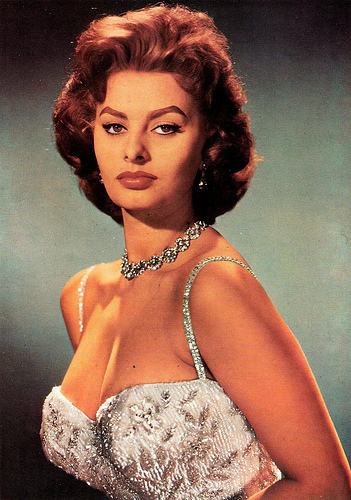
Vintage photo.
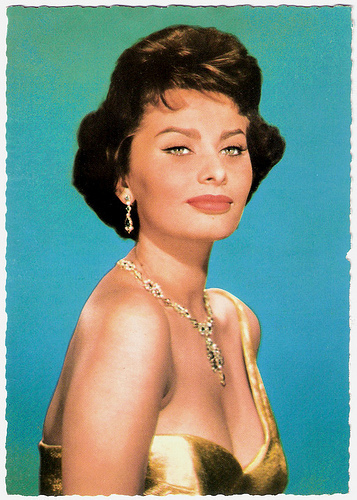
French postcard by E.D.U.G., no. 236.
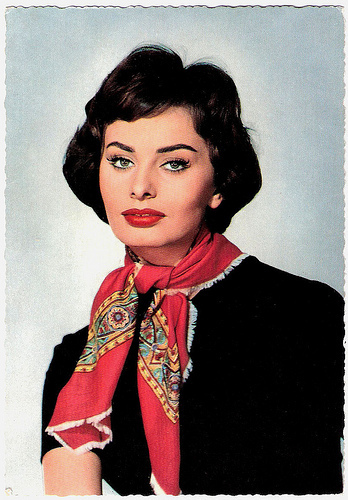
German postcard by Krüger, no. 902/147. Photo: UFA.
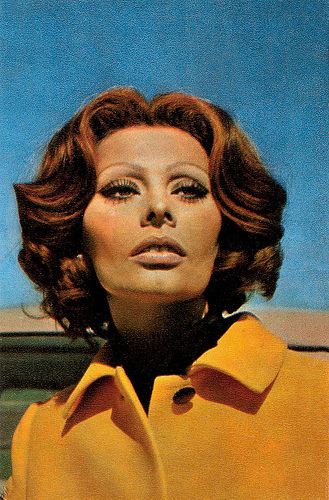
Russian postcard by Izdanije Byuro Propogandy Sovietskogo Kinoiskusstva, no. 4212, 1975. This postcard was printed in an edition of 300.000 cards. The price was 5 kop.
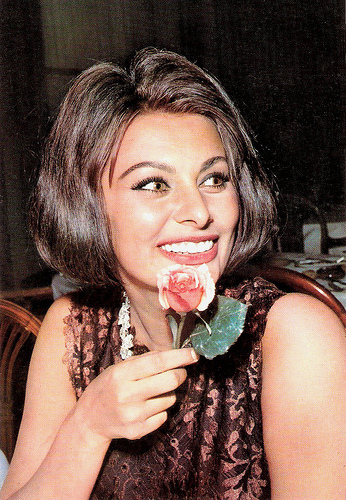
French postcard by Editions P.I., Paris, no. 1097. Photo: Anders.
And our favorite quote of her: After all these years, I am still involved in the process of self-discovery. It's better to explore life and make mistakes than to play it safe. Mistakes are part of the dues one pays for a full life.
Ms. Loren, tanti auguri! Cento di questi giorni!

Belgian postcard by Bromophoto, Brussels.

Italian postcard by Rotalfoto, Milano, no. 328. Photo: Ponti-De Laurentiis. Publicity still for La donna del fiume/Woman of the River (Mario Soldati, 1954).

German postcard printed by Krüger, no. 902/304. Photo: Georg Michalke. Publicity still for La donna del fiume/Woman of the River (Mario Soldati, 1954).

German postcard by UFA, no. 1007. Photo: UFA. Publicity still for La Bella Mugnaia/The Miller's Wife (Mario Camerini, 1955).

German postcard by Krüger, no. 902/446. Photo: Ufa.

French postcard by Editions du Globe (EDUG), Paris, no. 373. Photo: Sam Lévin.

French postcard by Edition du Globe, Paris, no. 374. Photo: Sam Lévin.

French postcard by Editions P.I., Paris, no. 946. Photo: Paramount Pictures, 1957.

German postcard by Universum-Film Aktiengesellschaft, Berlin-Tempelhof, no. 1631. Photo: Dial / Unitalia Film, Rome.

German postcard by ISV, no. A 93. Photo: 20th Century Fox. Publicity still for the British film The Millionairess (Anthony Asquith, 1960).

German postcard by Filmbilder-Vertrieb Ernst Freihoff, Essen, no. A 102. Photo: 20th Century Fox. Publicity still for The Millionairess (Anthony Asquith, 1960).

Dutch postcard. Photo: publicity still for El Cid (Anthony Mann, 1961).

Dutch postcard by Uitg. Takken, Utrecht, no. 4894. Photo: Hafbo. Publicity still for El Cid (Anthony Mann, 1961).

German postcard by Filmbilder-Vertrieb Ernst Freihoff, Essen, no. 5096. Photo: publicity still for Boccaccio '70 (Vittorio De Sica, 1962).

East-German card by VEB Progress Film-Vertrieb, Berlin, no. 2372, 1965. Photo: publicity still for Boccaccio '70 (Vittorio De Sica a.o., 1962).

Vintage photo.

French postcard by E.D.U.G., no. 236.

German postcard by Krüger, no. 902/147. Photo: UFA.

Russian postcard by Izdanije Byuro Propogandy Sovietskogo Kinoiskusstva, no. 4212, 1975. This postcard was printed in an edition of 300.000 cards. The price was 5 kop.

French postcard by Editions P.I., Paris, no. 1097. Photo: Anders.
And our favorite quote of her: After all these years, I am still involved in the process of self-discovery. It's better to explore life and make mistakes than to play it safe. Mistakes are part of the dues one pays for a full life.
Ms. Loren, tanti auguri! Cento di questi giorni!
Published on September 19, 2014 23:00
September 18, 2014
Raquel Meller
Spanish diva Raquel Meller (1888-1962) was already a highly popular singer before debuting as a film actress in 1919. She performed not only in Spain but also in France and the USA.
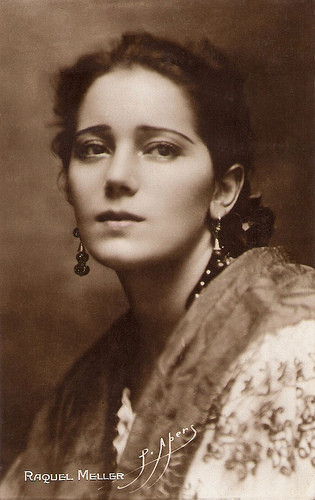
French postcard by Editions Cinémagazine. Photo: P. Apers.
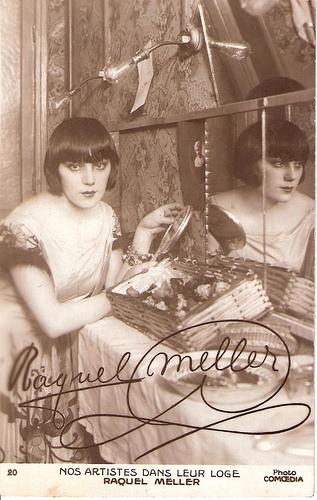
French postcard by Ed. Art de Comoedia, quotidien des théâtres. Concessionnaire: Editions Lafayette, Paris, no. 20.
Naughty Songs
Raquel Meller was born Francisca Marqués López in Tarazona, Spain, in 1888.
She studied in Tudela (Spain), and Montpellier (France), and started working as a dressmaker. It was a customer, Marta Oliver, a.k.a. the vaudeville star Mrs. Oliver, who introduced her to the music hall.
She began using her stage name Raquel Meller in 1907. She moved to Madrid and there she became famous as a cuplé (couplet) singer. These torch songs were considered 'naughty' and beneath the dignity (and morals) of a decent, serious singer.
Raquel, with her beauty and charismatic presence, raised the genre to high art and made it acceptable for the entire family (till then they were played in men-only bistros). Songs such as La Violetera, El Relicario, and Flor del Mal became standards - thanks to her interpretations.
She was the first Spanish popular singer to succeed in both Europe and the Americas, especially in the United States where her recordings enjoyed great popularity and her live concerts broke box office records. At one point she was under a exclusive contract with the famous Schuberts.
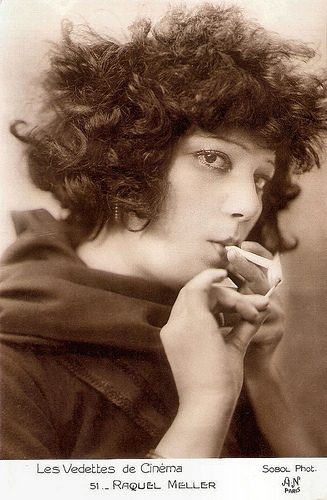
French postcard by A.N., Paris, in the series Les Vedettes de Cinéma, no. 51. Sent by mail in 1925. Photo: Sobol.
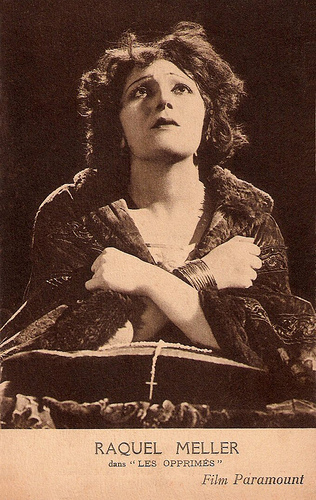
French postcard by Edition Paramount, Paris. Photo: Paramount. Publicity still from Les opprimés/The Oppressed (Henry Roussel, 1923).
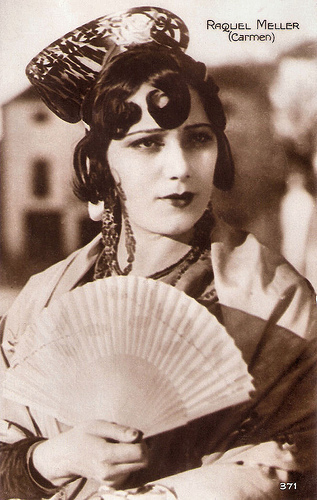
French postcard by Cinémagazine-Edition, Paris , no. 371. Photo: publicity still for Carmen (Jacques Feyder, 1926).
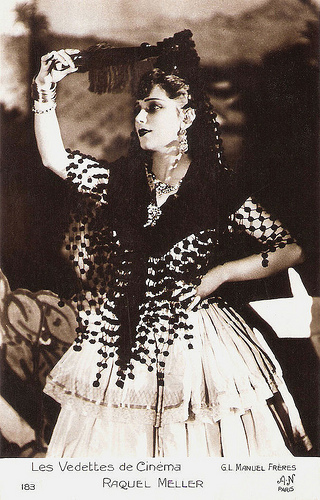
French postcard in the Les Vedettes de Cinema series by A.N., Paris, no. 183. Photo: G.L. Manuel Frères.
Spanish Flower Girl
Raquel Meller was also a hit on the big screen. She made her film debut in the Spanish film Los arlequines de seda y oro/The Harlequins of Silk and Gold (Ricardo de Baños, 1919).
In France she starred in such major films as Les opprimés/The Oppressed (Henry Roussel, 1923), Carmen (Jacques Feyder, 1926) opposite Austrian star Fred Louis Lerch , and Nocturne (Marcel Silver, 1927) again opposite Lerch.
Meller is best remembered for Violettes impériales/Imperial Violets (Henry Roussel, 1924), a historical romantic drama set during the reign of Napoleon III of France.
Meller played a Spanish flower girl who saves an attack on the life of the French empress Eugenie de Montijo (played by Suzanne Blanchetti ), by taking her place in her carriage. When the carriage is overthrown by the anarchist's bomb, the girl survives because of the masses of violets in the imperial carriage, the empress' favourite flowers.
In 1932, Henry Roussel made a sound version, again with Meller, and in 1948 an operetta version was made of the film. A tinted copy of the silent film was beautifully restored by the BFI some years ago and a clip of the film is visible in Kevin Brownlow's Cinema Europe series. However, we are still waiting for the DVD.
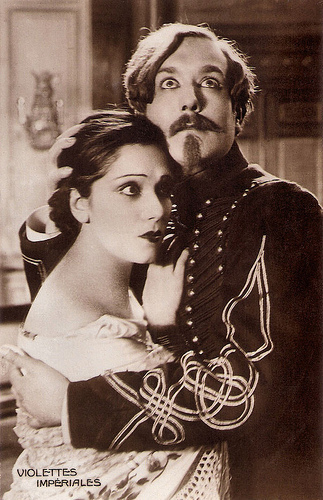
French postcard by Cinémagazine-Edition. Photo: publicity still for Violettes impériales/Imperial Violets (Henry Roussel, 1924) with André Roanne .
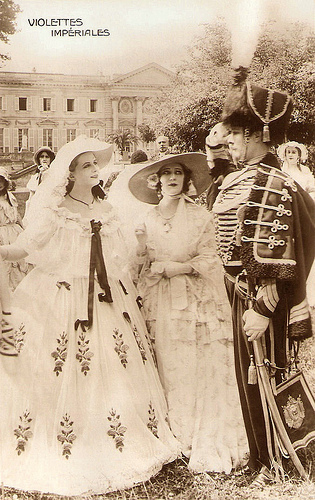
French postcard by Cinémagazine-Edition. Photo: publicity still for Violettes impériales/Imperial Violets (Henry Roussel, 1924) with Suzanne Blanchetti .
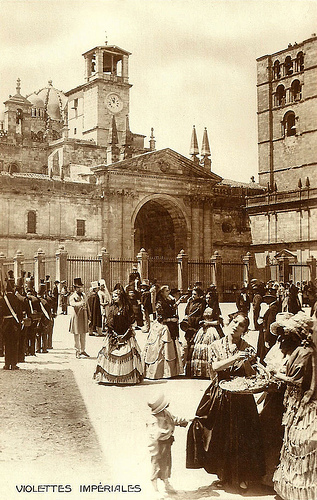
French postcard by Edition Cinémagazine. Photo: publicity still for Violettes impériales/Imperial Violets (Henry Roussel, 1924).
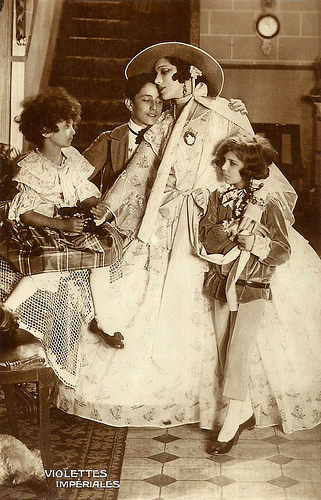
French postcard by Edition Cinémagazine. Photo: publicity still for Violettes impériales/Imperial Violets (Henry Roussel, 1924).
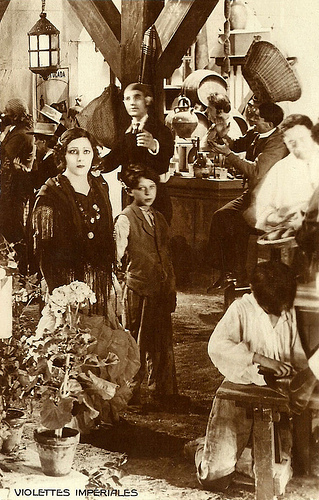
French postcard by Edition Cinémagazine. Photo: publicity still for Violettes impériales/Imperial Violets (Henry Roussel, 1924).
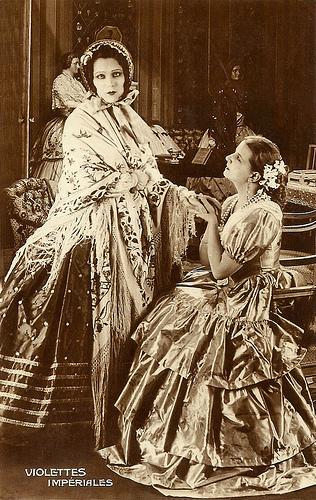
French postcard by Edition Cinémagazine. Photo: publicity still for Violettes impériales/Imperial Violets (Henry Roussel, 1924) with Suzanne Blanchetti .
Impossible Genius
Even if Sarah Bernhardt called her a 'genius', Raquel Meller could be impossible on the set.
When Jacques Feyder directed her in Carmen (1926), based on the oft-filmed Prosper Merimée novel, and Meller refused a kissing scene, he shouted that this was just how writer Prosper Merimée had intended it. At which Meller shouted back: I don't care about this Mr. Merimee. Where does he live? I'll call him by the phone!
Hal Erickson writes at AllMovie : "Director Feyder manages to transform this timeworn story into a feast for the eyes, especially during the climactic bullfighting sequence. When released in America in 1928, Carmen did surprisingly well, considering that Fox Pictures had recently produced its own version of the same story, with Dolores Del Rio as the ill-fated heroine."
Charles Chaplin , a big Meller fan, used her song La Violetera for the score of his classic City Lights (1931). She filmed in Hollywood several musical shorts for Fox at the advent of talkies and was a big draw in the vaudeville circuits for many years.
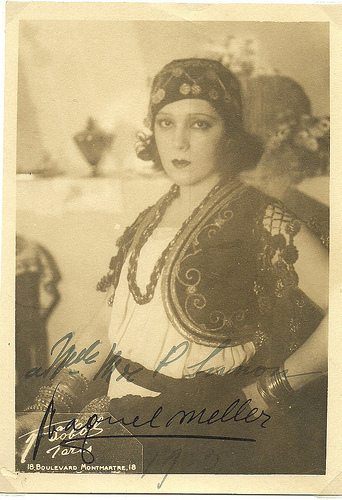
French postcard. Photo: Sobol, Paris. Collection: Didier Hanson.
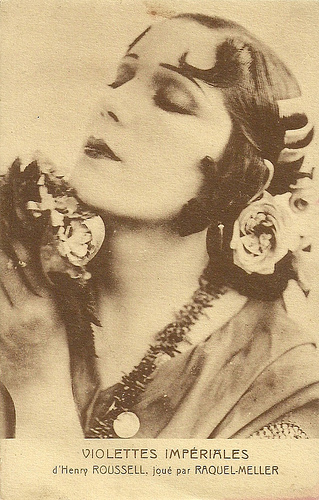
French postcard. Raquel Meller in Violettes impériales by Henry Roussel.
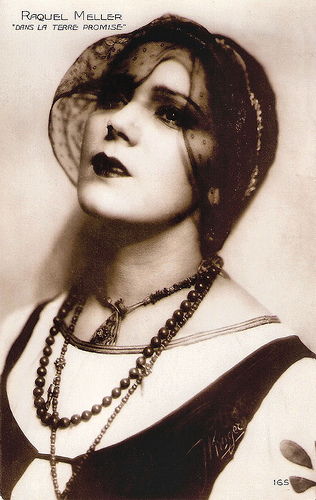
French postcard by Cinémagazine-Edition, Paris, no. 165. Photo: J. Kruger. Publicity still for La terre promise (Henry Roussel, 1925).
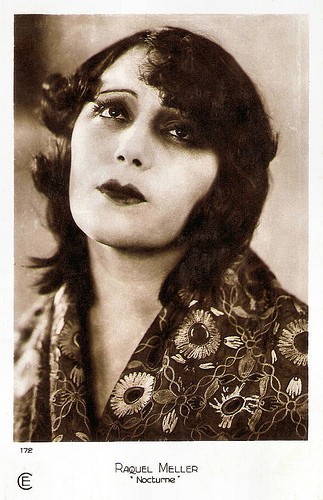
French postcard by Cinémagazine-Edition, Paris, no. 172. Photo: publicity still for Nocturne (Marcel Silver, 1927).
Imperious, Lovable, and Totally Egomaniac
The Spanish Civil War and the Second World War put an abrupt end to Raquel Meller's career.
She first left for Argentina and later retired in Barcelona. She only surfaced again in 1957 in the wake of Sara Montiel 's enormous success in the films El Ultimo Cuple/The Last Torch Song (Juan de Orduña, 1957) and La Violetera (Luis César Amadori, 1958) in which Montiel revived Raquel's greatest hits.
Meller hated it and threatened legal action but couldn't do anything. She attempted several big come backs, like in the vaudeville show Ha Salido Blanco y Negro! (1958), which were all both critical and commercial failures.
Bitterly, she retired in Barcelona and died there in 1962.
Meller's private life was always followed with great interest by the media and the public. She was imperious, ruthless (especially with the competition), lovable, funny, temperamental, witty and totally egomaniac. Her love life was described as 'healthy-plus' and among her many lovers there were royalty, heads of state and assorted VIPs.
Raquel Meller was married to Gomez Carillo and the French impresario Edmond Salac. She could never bear children so she adopted a boy and a girl. After her death in 1962 a book was published in France in which the author claimed that Raquel was instrumental in turning over Mata Hari to the French authorities since the famous spy-dancer was fooling around with one of her lovers.
The whole Raquel Meller-Mata Hari publicity was exploited in the film La Reina del chantecler/The Queen of Chantecler (Rafael Gil, 1962), starring Sara Montiel .
Most of Raquel Meller's recordings were considered lost for years, but lately they have been showing up on CD.
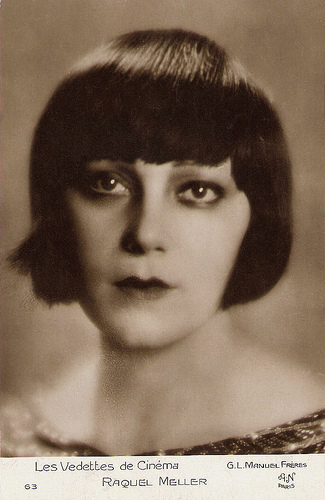
French postcard in the Les Vedettes de Cinéma Series by A.N., Paris , no. 63. Photo: G.L. Manuel Frères.
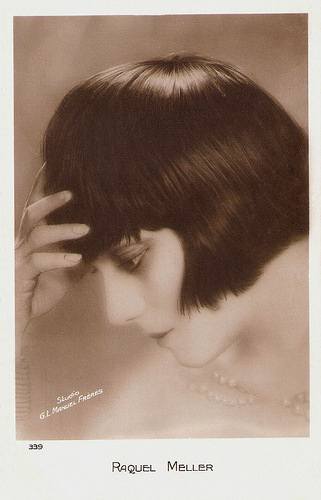
French postcard by Cinémagazine Edition, no. 339. Photo: G.L. Manuel Frères.
Original version of La Violetera. Raquel Meller sung it for the first time in 1907 at the Teatro Arnau in Barcelona. Source: Yoyama2 (YouTube).
Sources: (IMDb), Hal Erickson (AllMovie), Wikipedia (Spanish) and .

French postcard by Editions Cinémagazine. Photo: P. Apers.

French postcard by Ed. Art de Comoedia, quotidien des théâtres. Concessionnaire: Editions Lafayette, Paris, no. 20.
Naughty Songs
Raquel Meller was born Francisca Marqués López in Tarazona, Spain, in 1888.
She studied in Tudela (Spain), and Montpellier (France), and started working as a dressmaker. It was a customer, Marta Oliver, a.k.a. the vaudeville star Mrs. Oliver, who introduced her to the music hall.
She began using her stage name Raquel Meller in 1907. She moved to Madrid and there she became famous as a cuplé (couplet) singer. These torch songs were considered 'naughty' and beneath the dignity (and morals) of a decent, serious singer.
Raquel, with her beauty and charismatic presence, raised the genre to high art and made it acceptable for the entire family (till then they were played in men-only bistros). Songs such as La Violetera, El Relicario, and Flor del Mal became standards - thanks to her interpretations.
She was the first Spanish popular singer to succeed in both Europe and the Americas, especially in the United States where her recordings enjoyed great popularity and her live concerts broke box office records. At one point she was under a exclusive contract with the famous Schuberts.

French postcard by A.N., Paris, in the series Les Vedettes de Cinéma, no. 51. Sent by mail in 1925. Photo: Sobol.

French postcard by Edition Paramount, Paris. Photo: Paramount. Publicity still from Les opprimés/The Oppressed (Henry Roussel, 1923).

French postcard by Cinémagazine-Edition, Paris , no. 371. Photo: publicity still for Carmen (Jacques Feyder, 1926).

French postcard in the Les Vedettes de Cinema series by A.N., Paris, no. 183. Photo: G.L. Manuel Frères.
Spanish Flower Girl
Raquel Meller was also a hit on the big screen. She made her film debut in the Spanish film Los arlequines de seda y oro/The Harlequins of Silk and Gold (Ricardo de Baños, 1919).
In France she starred in such major films as Les opprimés/The Oppressed (Henry Roussel, 1923), Carmen (Jacques Feyder, 1926) opposite Austrian star Fred Louis Lerch , and Nocturne (Marcel Silver, 1927) again opposite Lerch.
Meller is best remembered for Violettes impériales/Imperial Violets (Henry Roussel, 1924), a historical romantic drama set during the reign of Napoleon III of France.
Meller played a Spanish flower girl who saves an attack on the life of the French empress Eugenie de Montijo (played by Suzanne Blanchetti ), by taking her place in her carriage. When the carriage is overthrown by the anarchist's bomb, the girl survives because of the masses of violets in the imperial carriage, the empress' favourite flowers.
In 1932, Henry Roussel made a sound version, again with Meller, and in 1948 an operetta version was made of the film. A tinted copy of the silent film was beautifully restored by the BFI some years ago and a clip of the film is visible in Kevin Brownlow's Cinema Europe series. However, we are still waiting for the DVD.

French postcard by Cinémagazine-Edition. Photo: publicity still for Violettes impériales/Imperial Violets (Henry Roussel, 1924) with André Roanne .

French postcard by Cinémagazine-Edition. Photo: publicity still for Violettes impériales/Imperial Violets (Henry Roussel, 1924) with Suzanne Blanchetti .

French postcard by Edition Cinémagazine. Photo: publicity still for Violettes impériales/Imperial Violets (Henry Roussel, 1924).

French postcard by Edition Cinémagazine. Photo: publicity still for Violettes impériales/Imperial Violets (Henry Roussel, 1924).

French postcard by Edition Cinémagazine. Photo: publicity still for Violettes impériales/Imperial Violets (Henry Roussel, 1924).

French postcard by Edition Cinémagazine. Photo: publicity still for Violettes impériales/Imperial Violets (Henry Roussel, 1924) with Suzanne Blanchetti .
Impossible Genius
Even if Sarah Bernhardt called her a 'genius', Raquel Meller could be impossible on the set.
When Jacques Feyder directed her in Carmen (1926), based on the oft-filmed Prosper Merimée novel, and Meller refused a kissing scene, he shouted that this was just how writer Prosper Merimée had intended it. At which Meller shouted back: I don't care about this Mr. Merimee. Where does he live? I'll call him by the phone!
Hal Erickson writes at AllMovie : "Director Feyder manages to transform this timeworn story into a feast for the eyes, especially during the climactic bullfighting sequence. When released in America in 1928, Carmen did surprisingly well, considering that Fox Pictures had recently produced its own version of the same story, with Dolores Del Rio as the ill-fated heroine."
Charles Chaplin , a big Meller fan, used her song La Violetera for the score of his classic City Lights (1931). She filmed in Hollywood several musical shorts for Fox at the advent of talkies and was a big draw in the vaudeville circuits for many years.

French postcard. Photo: Sobol, Paris. Collection: Didier Hanson.

French postcard. Raquel Meller in Violettes impériales by Henry Roussel.

French postcard by Cinémagazine-Edition, Paris, no. 165. Photo: J. Kruger. Publicity still for La terre promise (Henry Roussel, 1925).

French postcard by Cinémagazine-Edition, Paris, no. 172. Photo: publicity still for Nocturne (Marcel Silver, 1927).
Imperious, Lovable, and Totally Egomaniac
The Spanish Civil War and the Second World War put an abrupt end to Raquel Meller's career.
She first left for Argentina and later retired in Barcelona. She only surfaced again in 1957 in the wake of Sara Montiel 's enormous success in the films El Ultimo Cuple/The Last Torch Song (Juan de Orduña, 1957) and La Violetera (Luis César Amadori, 1958) in which Montiel revived Raquel's greatest hits.
Meller hated it and threatened legal action but couldn't do anything. She attempted several big come backs, like in the vaudeville show Ha Salido Blanco y Negro! (1958), which were all both critical and commercial failures.
Bitterly, she retired in Barcelona and died there in 1962.
Meller's private life was always followed with great interest by the media and the public. She was imperious, ruthless (especially with the competition), lovable, funny, temperamental, witty and totally egomaniac. Her love life was described as 'healthy-plus' and among her many lovers there were royalty, heads of state and assorted VIPs.
Raquel Meller was married to Gomez Carillo and the French impresario Edmond Salac. She could never bear children so she adopted a boy and a girl. After her death in 1962 a book was published in France in which the author claimed that Raquel was instrumental in turning over Mata Hari to the French authorities since the famous spy-dancer was fooling around with one of her lovers.
The whole Raquel Meller-Mata Hari publicity was exploited in the film La Reina del chantecler/The Queen of Chantecler (Rafael Gil, 1962), starring Sara Montiel .
Most of Raquel Meller's recordings were considered lost for years, but lately they have been showing up on CD.

French postcard in the Les Vedettes de Cinéma Series by A.N., Paris , no. 63. Photo: G.L. Manuel Frères.

French postcard by Cinémagazine Edition, no. 339. Photo: G.L. Manuel Frères.
Original version of La Violetera. Raquel Meller sung it for the first time in 1907 at the Teatro Arnau in Barcelona. Source: Yoyama2 (YouTube).
Sources: (IMDb), Hal Erickson (AllMovie), Wikipedia (Spanish) and .
Published on September 18, 2014 23:00
September 17, 2014
Oliver Grimm
Oliver Grimm (1948) was Germany's favourite child star for more than a decade, and made some 17 films between 1952 and 1963.
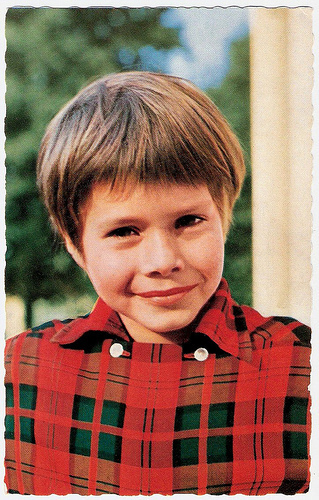
German postcard by Kolibri-Verlag G.m.b.H., Minden (Westf.), no. F 16. Photo: Constantin (Looschen). Publicity still for Kleiner Mann - ganz gross/Little Man on Top (Hans Grimm, 1957).
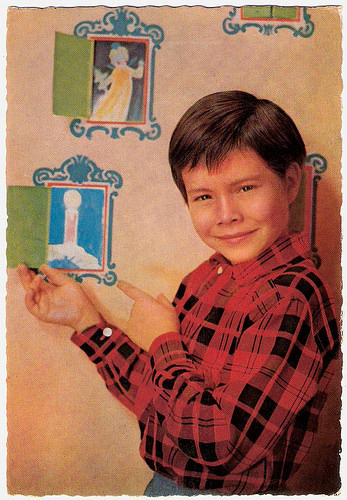
German postcard by WS-Druck, Wanne-Eickel, no. F 32. Photo: Niczky.
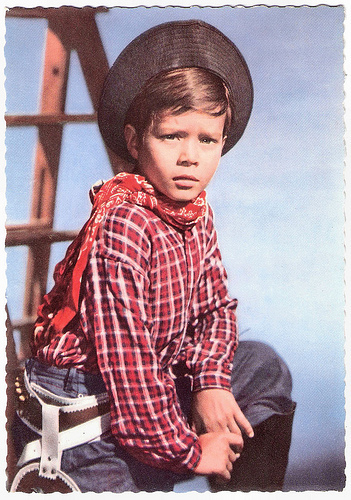
German postcard by Ufa, Berlin-Tempelhof, no. CK-29. Photo: Arthur Grimm / Ufa.
Handsome Boy Actor
Oliver Grimm was born in Munich, Germany, in 1948 as the son of film director Hans Grimm and Ufa-actress Hansi Wendler.
He already made his film debut in 1951 in the comedy Ich heiße Nicki/My name Is Nicki (Rudolf Jugert, 1952) starring Paul Hörbiger .
The following years more parts followed in Vater braucht eine Frau/Father Needs a Woman (Harald Braun, 1952) starring Dieter Borsche and Ruth Leuwerik , Moselfahrt aus Liebeskummer/A Boat Trip On the Mosel Because of Lovesickness (Kurt Hoffmann, 1953), Morgengrauen/Dawn (Viktor Tourjansky, 1954) and Frühlingslied/Springtime Song (Hans Albin, 1954).
It was his leading role in Wenn der Vater mit dem Sohne/Like father Like Son (Hans Quest, 1955) that made him one of the most famous child stars in Germany. In this film he co-starred as the son of a musical clown played by Heinz Rühmann .
Other family films with the handsome boy actor in the lead role soon followed as Griff nach den Sternen/Reaching for the Stars (Carl-Heinz Schroth, 1955), Mein Vater, der Schauspieler/May father, the Actor (Robert Siodmak, 1956) opposite O.W. Fischer , and Das schöne Abenteuer/Beautiful Adventure (Kurt Hoffmann, 1959) starring Liselotte Pulver .
He often appeared in films directed by his father, including Kleiner Mann: ganz groß/Little Man on Top (Hans Grimm, 1957) and Der schwarze Blitz/The Black Blitz (Hans Grimm, 1958) starring ski champion Toni Sailer .
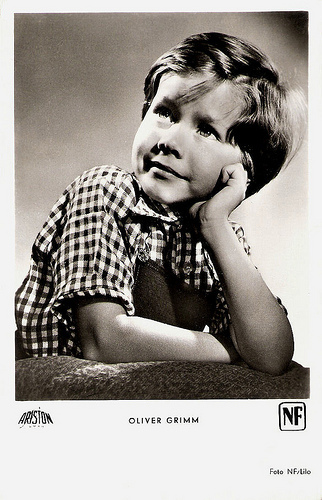
German postcard by Kunst und Bild, Berlin, no. A 1220 Photo: NF / Lilo. Publicity still for Morgengrauen/Dawn (Viktor Tourjansky, 1954).
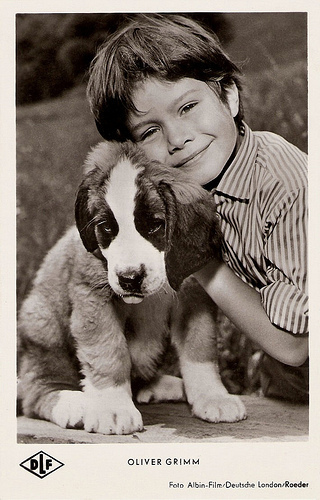
German postcard by Kunst und Bild, Berlin, no. 1279. Photo: Albin-Film / Deutsche London / Roeder. Publicity still for Frühlingslied/Springtime Song (Hans Albin, 1954).
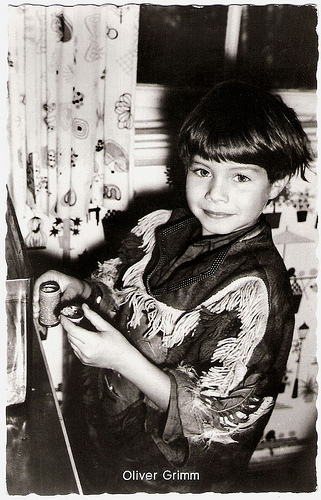
German postcard by Kolibri-Verlag G.m.b.H., Minden/Westf., no. 2000. Photo: H. / Fü.
Walt Disney
Internationally, Oliver Grimm may be best remembered for the role of a blind boy in two episodes of the television show Walt Disney’s Wonderful World of Color (Georg Tressler, 1962) opposite Karlheinz Böhm .
One of his best performances he gave in the British World War II drama Reach for Glory (Philip Leacock, 1962). A group of boys, evacuated from London to a coastal town, form a gang and play war games. Grimm played a jewish evacuee from Austria who runs off during a fight. The youths decide to give him a fake court-martial and he is killed by accident.
Grimm’s film career was over in 1963 when he was 14-years-of-age. He only provided the voice of Kimba the young lion in the German version of the Japanese animated series Janguru taitei/Kimba the White Lion (Eiichi Yamamoto, 1965-1967).
After leaving school Grimm studied three semesters with the intention to become a civil engineer. Then he decided for the acting profession, and took acting classes in Berlin.
As an adult he was not able to establish himself in the film business again, but since the 1970s he worked steadily as a voice actor and played at theatres in Berlin, Munich and Zurich. He also regularly works behind the camera.
In 1975 he made a guest appearance on TV in the popular krimi-series Derrick. After 38 years Oliver Grimm returned to the big screen as a teacher in the German comedy Schule/No More School (Marco Petry, 2000) starring Daniel Brühl.
His most recent screen appearances were interviews in the documentaries René Deltgen: Der sanfte Rebell/René Deltgen: The Gentle Rebel (Michael Wenk, 2004) and Heinz Rühmann - Der Schauspieler/Heinz Rühmann – The Actor (Michael Strauven, 2007) in the TV series Hitlers nützliche Idole/Hitler’s Useful Idols (2007).
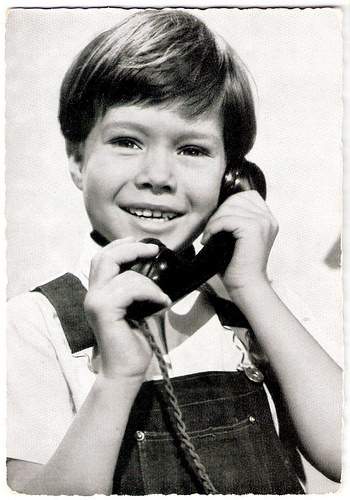
German postcard by WS-Druck, Wanne-Eickel, no. 231. Photo: Berolina / Constantin-Film.
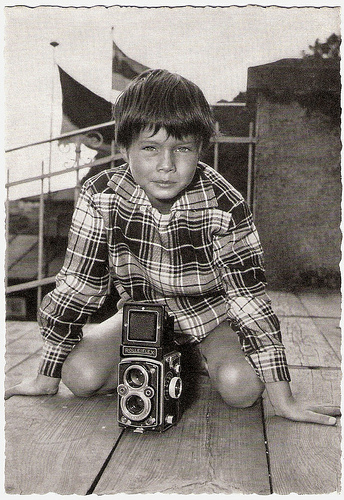
German postcard by WS-Druck, Wanne-Eickel, no. 152. Photo: Constantin / Bokelberg.
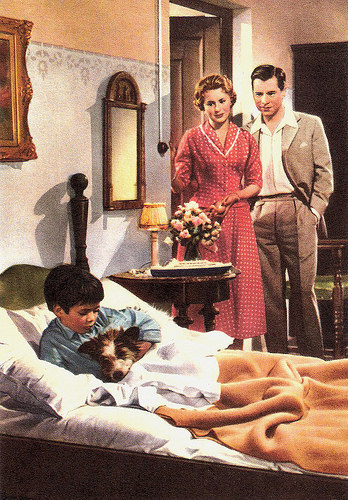
Italian postcard in the series 'Piccoli Uomini nel Cinema' by Ed. Villagio del Fanciullo, Bologna. Photo: Titanus. Publiity still for Wenn der Vater mit dem Sohne/If the Father and the Son (Hans Quest, 1955) with Waltraut Haas and Robert Freytag.
Scene from Vater braucht eine Frau/Father Needs a Woman (Harald Braun, 1952). Source: Liebhaberalterfilme (YouTube).
Scene from Wenn der Vater mit dem Sohne/Like father Like Son (Hans Quest, 1955). Source: Filmkiste (YouTube).
Sources: Stephanie D’heil (Steffi-line - German), Karl Williams (AllMovie), CVMC, Wikipedia (German) and .

German postcard by Kolibri-Verlag G.m.b.H., Minden (Westf.), no. F 16. Photo: Constantin (Looschen). Publicity still for Kleiner Mann - ganz gross/Little Man on Top (Hans Grimm, 1957).

German postcard by WS-Druck, Wanne-Eickel, no. F 32. Photo: Niczky.

German postcard by Ufa, Berlin-Tempelhof, no. CK-29. Photo: Arthur Grimm / Ufa.
Handsome Boy Actor
Oliver Grimm was born in Munich, Germany, in 1948 as the son of film director Hans Grimm and Ufa-actress Hansi Wendler.
He already made his film debut in 1951 in the comedy Ich heiße Nicki/My name Is Nicki (Rudolf Jugert, 1952) starring Paul Hörbiger .
The following years more parts followed in Vater braucht eine Frau/Father Needs a Woman (Harald Braun, 1952) starring Dieter Borsche and Ruth Leuwerik , Moselfahrt aus Liebeskummer/A Boat Trip On the Mosel Because of Lovesickness (Kurt Hoffmann, 1953), Morgengrauen/Dawn (Viktor Tourjansky, 1954) and Frühlingslied/Springtime Song (Hans Albin, 1954).
It was his leading role in Wenn der Vater mit dem Sohne/Like father Like Son (Hans Quest, 1955) that made him one of the most famous child stars in Germany. In this film he co-starred as the son of a musical clown played by Heinz Rühmann .
Other family films with the handsome boy actor in the lead role soon followed as Griff nach den Sternen/Reaching for the Stars (Carl-Heinz Schroth, 1955), Mein Vater, der Schauspieler/May father, the Actor (Robert Siodmak, 1956) opposite O.W. Fischer , and Das schöne Abenteuer/Beautiful Adventure (Kurt Hoffmann, 1959) starring Liselotte Pulver .
He often appeared in films directed by his father, including Kleiner Mann: ganz groß/Little Man on Top (Hans Grimm, 1957) and Der schwarze Blitz/The Black Blitz (Hans Grimm, 1958) starring ski champion Toni Sailer .

German postcard by Kunst und Bild, Berlin, no. A 1220 Photo: NF / Lilo. Publicity still for Morgengrauen/Dawn (Viktor Tourjansky, 1954).

German postcard by Kunst und Bild, Berlin, no. 1279. Photo: Albin-Film / Deutsche London / Roeder. Publicity still for Frühlingslied/Springtime Song (Hans Albin, 1954).

German postcard by Kolibri-Verlag G.m.b.H., Minden/Westf., no. 2000. Photo: H. / Fü.
Walt Disney
Internationally, Oliver Grimm may be best remembered for the role of a blind boy in two episodes of the television show Walt Disney’s Wonderful World of Color (Georg Tressler, 1962) opposite Karlheinz Böhm .
One of his best performances he gave in the British World War II drama Reach for Glory (Philip Leacock, 1962). A group of boys, evacuated from London to a coastal town, form a gang and play war games. Grimm played a jewish evacuee from Austria who runs off during a fight. The youths decide to give him a fake court-martial and he is killed by accident.
Grimm’s film career was over in 1963 when he was 14-years-of-age. He only provided the voice of Kimba the young lion in the German version of the Japanese animated series Janguru taitei/Kimba the White Lion (Eiichi Yamamoto, 1965-1967).
After leaving school Grimm studied three semesters with the intention to become a civil engineer. Then he decided for the acting profession, and took acting classes in Berlin.
As an adult he was not able to establish himself in the film business again, but since the 1970s he worked steadily as a voice actor and played at theatres in Berlin, Munich and Zurich. He also regularly works behind the camera.
In 1975 he made a guest appearance on TV in the popular krimi-series Derrick. After 38 years Oliver Grimm returned to the big screen as a teacher in the German comedy Schule/No More School (Marco Petry, 2000) starring Daniel Brühl.
His most recent screen appearances were interviews in the documentaries René Deltgen: Der sanfte Rebell/René Deltgen: The Gentle Rebel (Michael Wenk, 2004) and Heinz Rühmann - Der Schauspieler/Heinz Rühmann – The Actor (Michael Strauven, 2007) in the TV series Hitlers nützliche Idole/Hitler’s Useful Idols (2007).

German postcard by WS-Druck, Wanne-Eickel, no. 231. Photo: Berolina / Constantin-Film.

German postcard by WS-Druck, Wanne-Eickel, no. 152. Photo: Constantin / Bokelberg.

Italian postcard in the series 'Piccoli Uomini nel Cinema' by Ed. Villagio del Fanciullo, Bologna. Photo: Titanus. Publiity still for Wenn der Vater mit dem Sohne/If the Father and the Son (Hans Quest, 1955) with Waltraut Haas and Robert Freytag.
Scene from Vater braucht eine Frau/Father Needs a Woman (Harald Braun, 1952). Source: Liebhaberalterfilme (YouTube).
Scene from Wenn der Vater mit dem Sohne/Like father Like Son (Hans Quest, 1955). Source: Filmkiste (YouTube).
Sources: Stephanie D’heil (Steffi-line - German), Karl Williams (AllMovie), CVMC, Wikipedia (German) and .
Published on September 17, 2014 23:00
September 16, 2014
Adamo
Italian-Belgian composer and singer Salvatore Adamo (1943) was a teen idol in the first half of the 1960s. Occasionally he also starred in films.
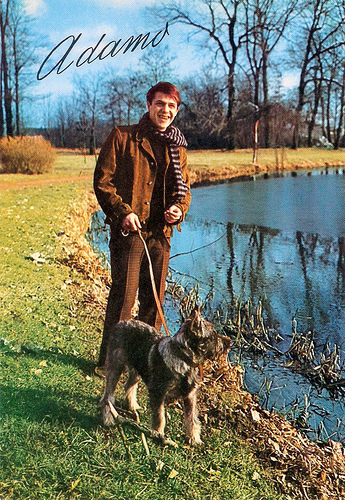
Dutch postcard by 't Sticht, Utrecht, Colour Serie no. 652.
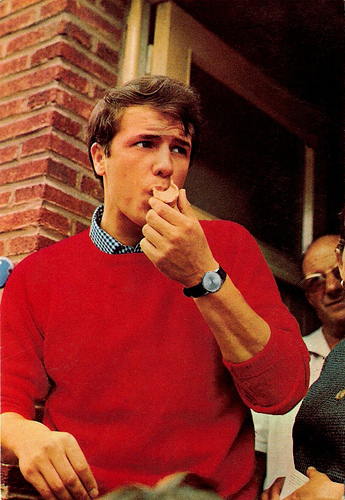
Dutch postcard by 't Sticht, Utrecht, no. 607.
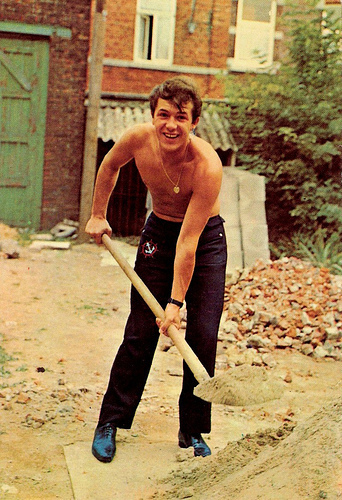
Dutch postcard by 't Sticht, Utrecht, no. 606.
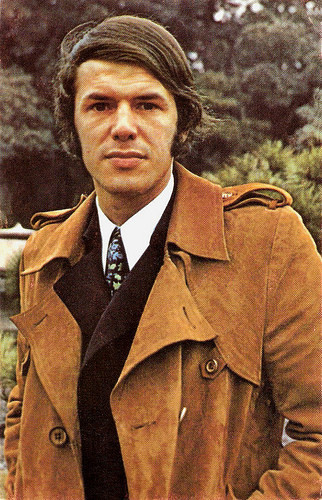
French postcard by Ed. Lyna, Paris, offered by Corvisart, no. AX 2015. Photo: Pathé Marconi.
The Coalmines of Marcinelle
Salvatore Adamo, simply known as Adamo, was born in the small commune of Comiso in Sicily, Italy, in 1943. When he was 3 his family emigrated to Belgium, where his father Antonio worked in the coalmines of Marcinelle.
In 1950, Salvatore was bedridden for a year with meningitis. Salvatore's parents did not want their son to become a miner and made great sacrifices to give him a good education, in a strict Catholic school run by the Frères des Ecoles Chrétiennes. Salvatore was a hard working, solitary student.
He started singing and composing his own songs from an early age. His debut was in a Radio Luxembourg competition in 1960. He participated as the singer and composer of the song Si j'osais/If I May and won the competition's final in Paris.
Shortly afterwards Adamo brought out his first single, without much success. Discouraged, he might have gone back to his studies if it hadn't been for the stubborn persistence of Antonio, who had his own ideas about his son's future. Together, they left for Paris, where they began doing the rounds of the music venues and record labels.
After four singles that went unnoticed Adamo had his first hit in 1963 with Sans toi, ma mie/Without You, My Sweet. It was a classical romantic number, completely different from the yéyé trend, the fusion of American rock and roll and French variety, that was all the rage at the time.
From then on, everything began to happen very quickly. On his twentieth birthday, he performed live at the Ancienne Belgique, the famous music hall in Brussels. He followed this up by doing a support act for Cliff Richard and the Shadows at another famous music venue, L'Olympia in Paris.
A series of hits followed, including Tombe la neige/Snow Falls, Vous permettez Monsieur/Allow Me, Sir and Les filles du bord de mer/The Girls at the Seashore.
Adamo has always remained faithful to the same style: this makes him known as the 'chanteur romantique par excellence'. With a characteristic, slightly broken voice Adamo sang his ballads mainly in French but also in other languages and he had commercial success in continental Europe, Japan and Latin America.
In 1964 he was the second biggest selling artist in the world, behind the Beatles . Reportedly he has now sold over 90 million albums worldwide.
His popularity in Japan began spectacularly with the incredible success of Tombe la neige, which remained at the top of the charts for 72 weeks. Nowadays one of the most widely known karaoke classics is the song Youki Wa Furu, the Japanese version of Tombe La Neige (the local Dreaming of a White Christmas).
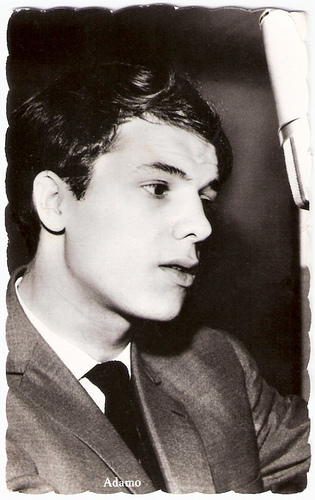
Dutch postcard by Gebr. Spanjersberg N.V. (SPARO), Rotterdam. Mailed in 1967. Publicity card for His Master's Voice for the single Dolce Paola/A vot'bon coeur.
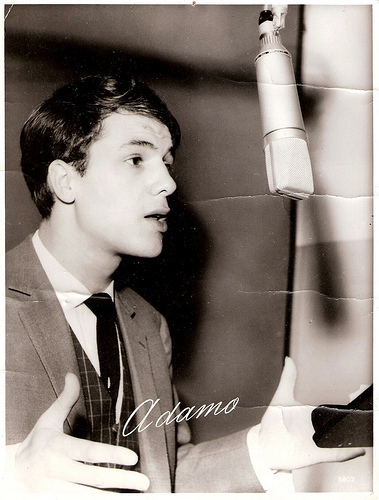
Big Dutch photocard.
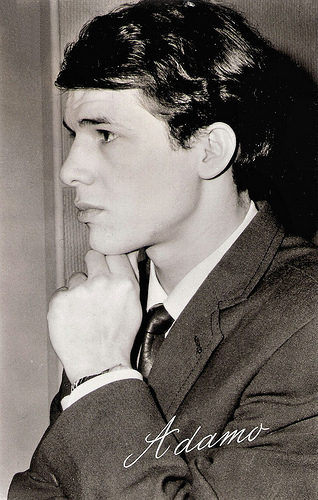
Dutch postcard by Uitgeverij Takken, no. AX 5461.
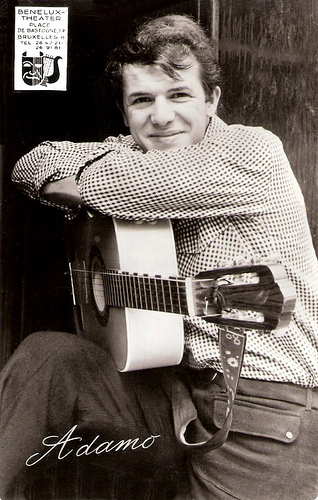
Dutch postcard by 't Sticht, Utrecht, no. AX 5934, sent by mail in 1965. Photo: 't Sticht. Publicity card for R. Bylois / Benelux Theater, Bruxelles (Brussels).
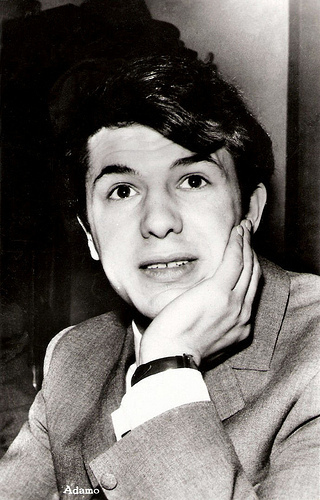
Dutch postcard by Gebr. Spanjersberg, Rotterdam (ca. 1965). Photo: His Master’s Voice for the single Dolce Paola/A vot’bon coeur.
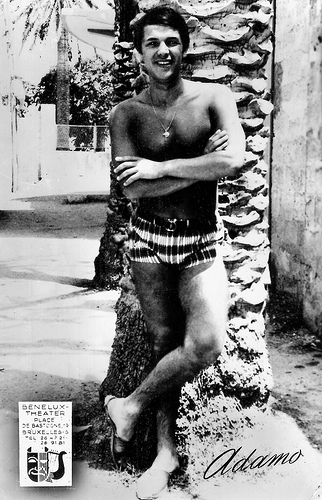
Dutch postcard by 't Sticht, Utrecht, no. 6829. Photo: Eddy Despretz.
Film Acting
Adamo attempted film acting in the crime dramas Les Arnaud/The Arnauds (Léo Joannon, 1967), starring Bourvil , and L’ardoise/The Comeuppance (Claude Bernard-Aubert, 1970).
He even wrote and directed a film himself, L’Île aux coquelicots/The Isle of Coquelicots (1970), but it was a flop.
At the end of the sixties, Adamo married his wife, Nicole. Their son, Anthony, was born in 1969.
In the 1980s Adamo's career faltered. His style of music was no longer fashionable. Since the 1990s however, on the crest of a nostalgia wave, he has successfully resumed composing, issuing records and touring, starting with a full season at the Casino de Paris venue in April 1990.
In 1993 Adamo got an extreme boost in popularity in Belgium thanks to a splendid adaptation singer Arno did of his song Les filles du bord de mer.
Since 1993, Adamo is a honorary Unicef ambassador from Belgium. In 2001 he was named a Chevalier by the Belgian king.
Adamo had a brain haemorrhage in 2004. For a time he had problems with talking, but he has recovered now completely.
His songs were featured on soundtracks of many films, including the camp musical 20 centímetros/20 Centimeters (Ramon Salazar, 2005) and the neo-noir Arrivederci amore, ciao/The Goodbye Kiss (Michele Soavi, 2006) starring Michele Placido.
Adamo himself appeared in another film Laisse tes mains sur mes hanches/Leave Your Hands On My Hips (Chantal Lauby, 2003) and composed the score of Mineurs/Miners (Fulvio Wetzl, 2007), a documentary about the children of Italian coalminers.
Nowadays Adamo lives in Belgium and is still touring. His most recent cd is Le bal des gens bien/The Dance of the Good People, containing duets with the stars of the French chanson. According to RFI Musique, the album received rave reviews from the critics and proved to be a big hit with record-buyers, too.
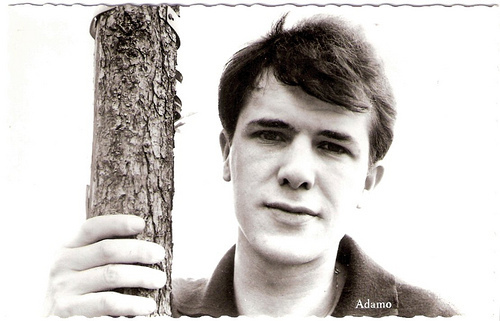
Dutch postcard, no. 1039.
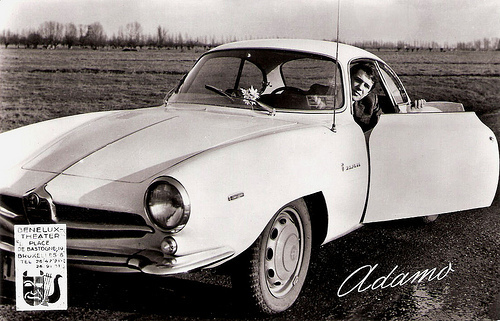
Dutch postcard by 't Sticht, Utrecht, no. 6154. Photo: Benelux Theater, Bruxelles.
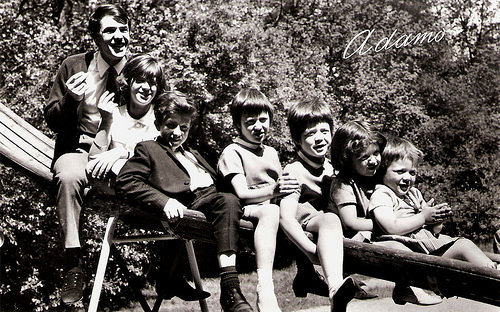
Dutch postcard by 't Sticht, Utrecht / Uitgeverij Takken, no. AX 5826. Photo: NV Bovema.
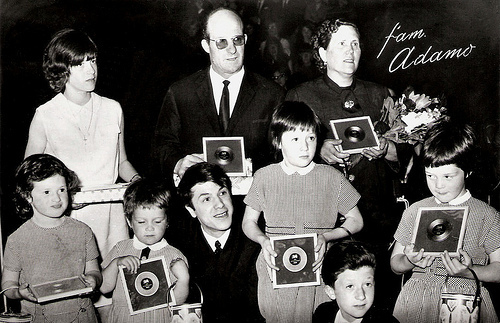
Dutch postcard by 't Sticht, Utrecht / Uitgeverij Takken, no. AX 5820. Photo: NV Bovema.
Adamo sings a multilingual version of Vous permettez Monsieur in this early Dutch videoclip (1964). Source: AdamoLuisPeru (YouTube).
Adamo sings Petit Bonheur in a vintage Scopitone film. Source: plotbox (YouTube).
Sources: Dirk Houbrechts (The Belgian Pop & Rock Archives), RFI Musique (French), Wikipedia, and .

Dutch postcard by 't Sticht, Utrecht, Colour Serie no. 652.

Dutch postcard by 't Sticht, Utrecht, no. 607.

Dutch postcard by 't Sticht, Utrecht, no. 606.

French postcard by Ed. Lyna, Paris, offered by Corvisart, no. AX 2015. Photo: Pathé Marconi.
The Coalmines of Marcinelle
Salvatore Adamo, simply known as Adamo, was born in the small commune of Comiso in Sicily, Italy, in 1943. When he was 3 his family emigrated to Belgium, where his father Antonio worked in the coalmines of Marcinelle.
In 1950, Salvatore was bedridden for a year with meningitis. Salvatore's parents did not want their son to become a miner and made great sacrifices to give him a good education, in a strict Catholic school run by the Frères des Ecoles Chrétiennes. Salvatore was a hard working, solitary student.
He started singing and composing his own songs from an early age. His debut was in a Radio Luxembourg competition in 1960. He participated as the singer and composer of the song Si j'osais/If I May and won the competition's final in Paris.
Shortly afterwards Adamo brought out his first single, without much success. Discouraged, he might have gone back to his studies if it hadn't been for the stubborn persistence of Antonio, who had his own ideas about his son's future. Together, they left for Paris, where they began doing the rounds of the music venues and record labels.
After four singles that went unnoticed Adamo had his first hit in 1963 with Sans toi, ma mie/Without You, My Sweet. It was a classical romantic number, completely different from the yéyé trend, the fusion of American rock and roll and French variety, that was all the rage at the time.
From then on, everything began to happen very quickly. On his twentieth birthday, he performed live at the Ancienne Belgique, the famous music hall in Brussels. He followed this up by doing a support act for Cliff Richard and the Shadows at another famous music venue, L'Olympia in Paris.
A series of hits followed, including Tombe la neige/Snow Falls, Vous permettez Monsieur/Allow Me, Sir and Les filles du bord de mer/The Girls at the Seashore.
Adamo has always remained faithful to the same style: this makes him known as the 'chanteur romantique par excellence'. With a characteristic, slightly broken voice Adamo sang his ballads mainly in French but also in other languages and he had commercial success in continental Europe, Japan and Latin America.
In 1964 he was the second biggest selling artist in the world, behind the Beatles . Reportedly he has now sold over 90 million albums worldwide.
His popularity in Japan began spectacularly with the incredible success of Tombe la neige, which remained at the top of the charts for 72 weeks. Nowadays one of the most widely known karaoke classics is the song Youki Wa Furu, the Japanese version of Tombe La Neige (the local Dreaming of a White Christmas).

Dutch postcard by Gebr. Spanjersberg N.V. (SPARO), Rotterdam. Mailed in 1967. Publicity card for His Master's Voice for the single Dolce Paola/A vot'bon coeur.

Big Dutch photocard.

Dutch postcard by Uitgeverij Takken, no. AX 5461.

Dutch postcard by 't Sticht, Utrecht, no. AX 5934, sent by mail in 1965. Photo: 't Sticht. Publicity card for R. Bylois / Benelux Theater, Bruxelles (Brussels).

Dutch postcard by Gebr. Spanjersberg, Rotterdam (ca. 1965). Photo: His Master’s Voice for the single Dolce Paola/A vot’bon coeur.

Dutch postcard by 't Sticht, Utrecht, no. 6829. Photo: Eddy Despretz.
Film Acting
Adamo attempted film acting in the crime dramas Les Arnaud/The Arnauds (Léo Joannon, 1967), starring Bourvil , and L’ardoise/The Comeuppance (Claude Bernard-Aubert, 1970).
He even wrote and directed a film himself, L’Île aux coquelicots/The Isle of Coquelicots (1970), but it was a flop.
At the end of the sixties, Adamo married his wife, Nicole. Their son, Anthony, was born in 1969.
In the 1980s Adamo's career faltered. His style of music was no longer fashionable. Since the 1990s however, on the crest of a nostalgia wave, he has successfully resumed composing, issuing records and touring, starting with a full season at the Casino de Paris venue in April 1990.
In 1993 Adamo got an extreme boost in popularity in Belgium thanks to a splendid adaptation singer Arno did of his song Les filles du bord de mer.
Since 1993, Adamo is a honorary Unicef ambassador from Belgium. In 2001 he was named a Chevalier by the Belgian king.
Adamo had a brain haemorrhage in 2004. For a time he had problems with talking, but he has recovered now completely.
His songs were featured on soundtracks of many films, including the camp musical 20 centímetros/20 Centimeters (Ramon Salazar, 2005) and the neo-noir Arrivederci amore, ciao/The Goodbye Kiss (Michele Soavi, 2006) starring Michele Placido.
Adamo himself appeared in another film Laisse tes mains sur mes hanches/Leave Your Hands On My Hips (Chantal Lauby, 2003) and composed the score of Mineurs/Miners (Fulvio Wetzl, 2007), a documentary about the children of Italian coalminers.
Nowadays Adamo lives in Belgium and is still touring. His most recent cd is Le bal des gens bien/The Dance of the Good People, containing duets with the stars of the French chanson. According to RFI Musique, the album received rave reviews from the critics and proved to be a big hit with record-buyers, too.

Dutch postcard, no. 1039.

Dutch postcard by 't Sticht, Utrecht, no. 6154. Photo: Benelux Theater, Bruxelles.

Dutch postcard by 't Sticht, Utrecht / Uitgeverij Takken, no. AX 5826. Photo: NV Bovema.

Dutch postcard by 't Sticht, Utrecht / Uitgeverij Takken, no. AX 5820. Photo: NV Bovema.
Adamo sings a multilingual version of Vous permettez Monsieur in this early Dutch videoclip (1964). Source: AdamoLuisPeru (YouTube).
Adamo sings Petit Bonheur in a vintage Scopitone film. Source: plotbox (YouTube).
Sources: Dirk Houbrechts (The Belgian Pop & Rock Archives), RFI Musique (French), Wikipedia, and .
Published on September 16, 2014 23:00
September 15, 2014
Albert Lieven
German character actor Albert Lieven (1906–1971) fled from Nazi Germany to Great Britain. During WW II, he appeared in several British films, often cast as the humourless military. Till the 1970s, he appeared in German and British films and on television.
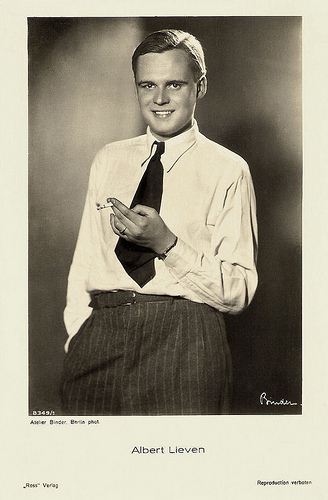
German postcard by Ross Verlag, no. 8349/1, 1934-1935. Photo: Atelier Binder, Berlin.
The impetuous young man
Albert Lieven was born Albert Fritz Liévin in Hohenstein, Germany (now Olsztynek, Poland) in 1906. His father, Dr. Walter Liévin, was a renowned lung specialist, and his family produced more noted physicians.
Albert grew up in East Prussia. He first acted on stage at the Hoftheater in Gera in 1928, and later in the ensemble cast at the Preussische Staatstheater in Berlin.
He started his screen career as a dashing young ensign in the German comedy Annemarie, die Braut der Kompanie/Bride of the Company (Carl Boese, 1932) featuring Lucie Englisch .
It was followed by the musical comedy Ich bei Tag und du bei Nacht/I by Day, You by Night (Ludwig Berger, 1932) starring Käthe von Nagy and Willy Fritsch .
During the next four years he appeared as the impetuous young man or romantic lead in another fifteen films, including in the melodrama Reifende Jugend/The growing youth (Carl Froelich, 1933) with Heinrich George , and a German film adaptation of the cross-dressing farce Charley's Aunt, Charleys Tante (Robert A. Stemmle, 1934) with Fritz Rasp and Paul Kemp .
In 1936, owing to the rise of the Nazi Party in Germany and his wife being Jewish, he emigrated over France to Britain (according to Wikipedia his wife was Tatjana Lieven; IMDb mistakenly mentions Petra Peters – but she was born in 1925).
His first stage role in the West End was as Prince Ernest of Saxe-Cobourg and Gotha in Laurence Housman’s play Victoria Regina in 1937. In the screen adaptation, Victoria the Great (Herbert Wilcox, 1937), his part was played by Walter Rilla . Lieven only had a bit part in this historical film, starring Anna Neagle as Queen Victoria.
On the London stage, he also appeared in the comedy Rake's Progress and the drama The Deacon and the Jewess, which were both entirely televised by the BBC in 1939. Lieven also featured in BBC foreign service radio broadcasts as a newsreader and reporter.
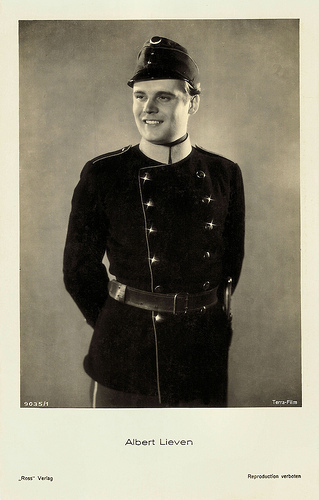
German postcard by Ross Verlag, no. 9035/1, 1935-1936. Photo: Terra-Film.
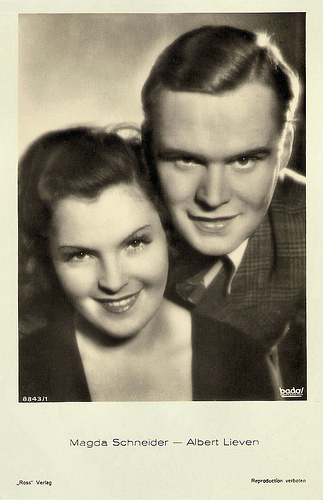
German postcard by Ross Verlag, no. 8843/1, 1934-1935. Photo: Badal Filmproduktion. Publicity still for Fräulein Liselott/Miss Liselott (Johannes Guter, 1934) with Magda Schneider .
The Nazi villain or snarling Prussian
During World War II, Albert Lieven stayed in Great Britain. From 1939 to 1951 he was affiliated with the Rank Organization as a character actor. In the year 1940, he was credited in seven British films.
In many films he played the Nazi villain or snarling Prussian, such as a concentration camp guard in the war thriller Night Train to Munich (Carol Reed, 1940) with Margaret Lockwood and Rex Harrison .
Hal Erickson at AllMovie : “His characters weren't all Nazis, though many of them behaved as though their first words as infants had been ‘Sieg heil.’”
His best known films of the war period include the romantic drama The Life and Death of Colonel Blimp (Michael Powell, Emeric Pressburger, 1943) with Roger Livesey, and the psychological melodrama The Seventh Veil (Compton Bennett, 1945) with James Mason and Ann Todd .
In 1948, Lieven performed on Broadway in Terrence Rattigan’s play Winslow Boy, and next did some international tours.
In 1951 (or 1952 – the sources differ), he returned to Germany, and there he also appeared on TV and in many films. The first was Die Dubarry/Madame Dubarry (Georg Wildhagen, Reinhold Schünzel, 1951) with Sari Barabas and Willy Fritsch .
Other German films were the crime film Das Bekenntnis der Ina Kahr/The Confession of Ina Kahr (Georg Wilhelm Pabst, 1954) featuring Elisabeth Müller, and the war drama Des Teufels General/The Devil's General (Helmut Käutner, 1955) with Curd Jürgens .
He also continued to appear in both British films as well as in Hollywood productions. The best known is the all-star adventure film The Guns of Navarone (J. Lee Thompson, 1961), in which he once again played a German commandant, and the war film The Victors (Carl Foreman, 1963).
On TV he was often seen in German crime series, based on the popular novels by Francis Durbridge.
His final film appearance was in the nostalgic German comedy Die Feuerzangenbowle/The Hot Wine Punch (Helmut Käutner, 1970) with Walter Giller .
In 1971, Albert Lieven died of cancer at home in Farnham near London, England. He was 65. Lieven was married five times, to Anne-Marie Schäfer-Röhrig Tatjana (Tania) Silbermann, Valerie White, Susan Shaw and Petra Peters. All marriages ended in a divorce. He had a son from his second marriage and a daughter, Anna Lieven, from his marriage with British film star Susan Shaw . His grandson is the Newcastle and England rugby player Toby Flood.
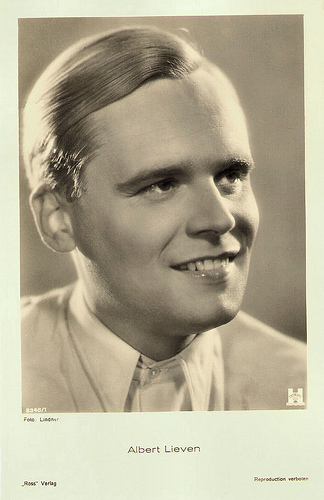
German postcard by Ross Verlag, no. 8348/1, 1934-1935. Photo: Lindner / Hisa Film.
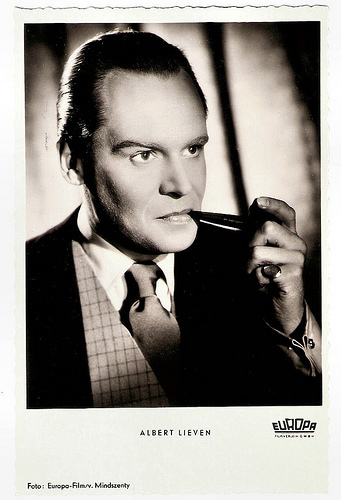
German postcard by Kunst und Bild, Berlin, A 585. Photo: Europa-Film / Von Mindszenty. Publicity still for Klettermaxe/Corry Bell (Kurt Hoffmann, 1952).
Sources: Hans-Michael Bock and Tim Bergfelder (The Concise Cinegraph - German), Stephanie D’heil (Steffi-line - German), Peter Ritter (Ostpreussen - German), Richard Kay (MailOnline), Wikipedia, and .

German postcard by Ross Verlag, no. 8349/1, 1934-1935. Photo: Atelier Binder, Berlin.
The impetuous young man
Albert Lieven was born Albert Fritz Liévin in Hohenstein, Germany (now Olsztynek, Poland) in 1906. His father, Dr. Walter Liévin, was a renowned lung specialist, and his family produced more noted physicians.
Albert grew up in East Prussia. He first acted on stage at the Hoftheater in Gera in 1928, and later in the ensemble cast at the Preussische Staatstheater in Berlin.
He started his screen career as a dashing young ensign in the German comedy Annemarie, die Braut der Kompanie/Bride of the Company (Carl Boese, 1932) featuring Lucie Englisch .
It was followed by the musical comedy Ich bei Tag und du bei Nacht/I by Day, You by Night (Ludwig Berger, 1932) starring Käthe von Nagy and Willy Fritsch .
During the next four years he appeared as the impetuous young man or romantic lead in another fifteen films, including in the melodrama Reifende Jugend/The growing youth (Carl Froelich, 1933) with Heinrich George , and a German film adaptation of the cross-dressing farce Charley's Aunt, Charleys Tante (Robert A. Stemmle, 1934) with Fritz Rasp and Paul Kemp .
In 1936, owing to the rise of the Nazi Party in Germany and his wife being Jewish, he emigrated over France to Britain (according to Wikipedia his wife was Tatjana Lieven; IMDb mistakenly mentions Petra Peters – but she was born in 1925).
His first stage role in the West End was as Prince Ernest of Saxe-Cobourg and Gotha in Laurence Housman’s play Victoria Regina in 1937. In the screen adaptation, Victoria the Great (Herbert Wilcox, 1937), his part was played by Walter Rilla . Lieven only had a bit part in this historical film, starring Anna Neagle as Queen Victoria.
On the London stage, he also appeared in the comedy Rake's Progress and the drama The Deacon and the Jewess, which were both entirely televised by the BBC in 1939. Lieven also featured in BBC foreign service radio broadcasts as a newsreader and reporter.

German postcard by Ross Verlag, no. 9035/1, 1935-1936. Photo: Terra-Film.

German postcard by Ross Verlag, no. 8843/1, 1934-1935. Photo: Badal Filmproduktion. Publicity still for Fräulein Liselott/Miss Liselott (Johannes Guter, 1934) with Magda Schneider .
The Nazi villain or snarling Prussian
During World War II, Albert Lieven stayed in Great Britain. From 1939 to 1951 he was affiliated with the Rank Organization as a character actor. In the year 1940, he was credited in seven British films.
In many films he played the Nazi villain or snarling Prussian, such as a concentration camp guard in the war thriller Night Train to Munich (Carol Reed, 1940) with Margaret Lockwood and Rex Harrison .
Hal Erickson at AllMovie : “His characters weren't all Nazis, though many of them behaved as though their first words as infants had been ‘Sieg heil.’”
His best known films of the war period include the romantic drama The Life and Death of Colonel Blimp (Michael Powell, Emeric Pressburger, 1943) with Roger Livesey, and the psychological melodrama The Seventh Veil (Compton Bennett, 1945) with James Mason and Ann Todd .
In 1948, Lieven performed on Broadway in Terrence Rattigan’s play Winslow Boy, and next did some international tours.
In 1951 (or 1952 – the sources differ), he returned to Germany, and there he also appeared on TV and in many films. The first was Die Dubarry/Madame Dubarry (Georg Wildhagen, Reinhold Schünzel, 1951) with Sari Barabas and Willy Fritsch .
Other German films were the crime film Das Bekenntnis der Ina Kahr/The Confession of Ina Kahr (Georg Wilhelm Pabst, 1954) featuring Elisabeth Müller, and the war drama Des Teufels General/The Devil's General (Helmut Käutner, 1955) with Curd Jürgens .
He also continued to appear in both British films as well as in Hollywood productions. The best known is the all-star adventure film The Guns of Navarone (J. Lee Thompson, 1961), in which he once again played a German commandant, and the war film The Victors (Carl Foreman, 1963).
On TV he was often seen in German crime series, based on the popular novels by Francis Durbridge.
His final film appearance was in the nostalgic German comedy Die Feuerzangenbowle/The Hot Wine Punch (Helmut Käutner, 1970) with Walter Giller .
In 1971, Albert Lieven died of cancer at home in Farnham near London, England. He was 65. Lieven was married five times, to Anne-Marie Schäfer-Röhrig Tatjana (Tania) Silbermann, Valerie White, Susan Shaw and Petra Peters. All marriages ended in a divorce. He had a son from his second marriage and a daughter, Anna Lieven, from his marriage with British film star Susan Shaw . His grandson is the Newcastle and England rugby player Toby Flood.

German postcard by Ross Verlag, no. 8348/1, 1934-1935. Photo: Lindner / Hisa Film.

German postcard by Kunst und Bild, Berlin, A 585. Photo: Europa-Film / Von Mindszenty. Publicity still for Klettermaxe/Corry Bell (Kurt Hoffmann, 1952).
Sources: Hans-Michael Bock and Tim Bergfelder (The Concise Cinegraph - German), Stephanie D’heil (Steffi-line - German), Peter Ritter (Ostpreussen - German), Richard Kay (MailOnline), Wikipedia, and .
Published on September 15, 2014 23:00
September 14, 2014
Joan Collins
Glamorous English actress Joan Collins (1933) is one of the great survivors of the cinema. She began in the early 1950s as a voluptuous starlet of British film. 20th Century Fox brought her to Hollywood as their answer to Elizabeth Taylor. In the 1970s she was the ‘Queen of the B-pictures’, but in the 1980s Joan became the highest-paid TV star, thanks to Dynasty.
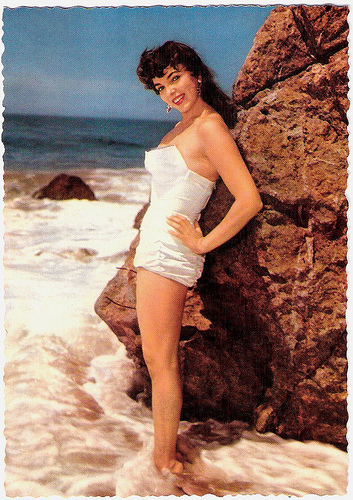
German postcard by FHAK.
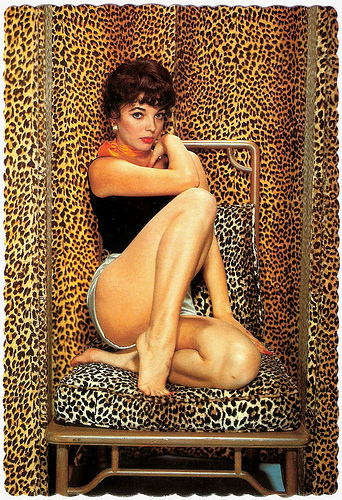
Canadian postcard in the Fan Club Postcard Series, no. 2.
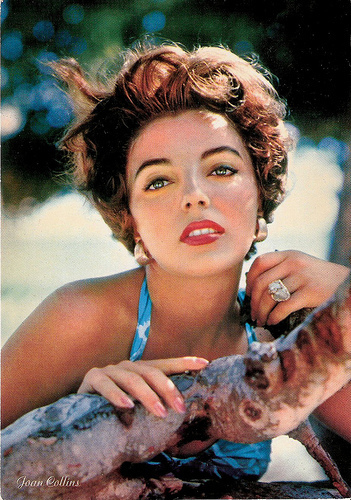
Italian postcard by Ed. Ris. Rotalfoto S.p.A., Milano (Milan) in the series Artisti di Sempre, no. 295.
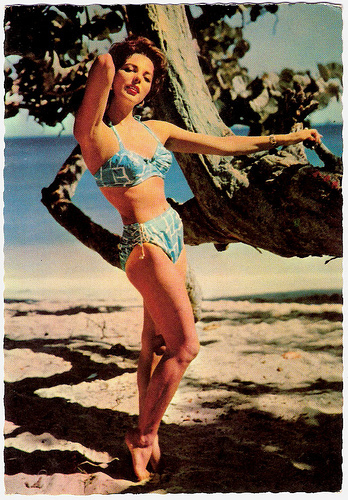
German postcard.
Perennial Starlet
Joan Henrietta Collins was born in Paddington, London, in 1933 (some sources say 1931 or 1935). She was the daughter of Elsa (née Bessant), a dance teacher and nightclub hostess, and Joseph William Collins, an agent whose clients would later included Shirley Bassey, The Beatles and Tom Jones . She has one sister, the author Jackie Collins, and a brother, real estate agent Bill Collins.
Joan was educated at the Francis Holland School and then trained at the Royal Academy of Dramatic Art (RADA). In 1951, she made her feature debut in a small role as a beauty contestant in the comedy Lady Godiva Rides Again (Frank Launder, 1951). The next year she left RADA and starred in the crime drama Cosh Boy (Lewis Gilbert, 1952), and appeared as a juvenile delinquent in I Believe in You (Basil Dearden, Michael Relph, 1952).
The Rank Organisation then took an interest in Collins and gave her a contract. Rank set about moulding Joan into their idea of a well-groomed film star. They entrusted her to Cornel Lucas, their top stills photographer. Lucas, who was married to Belinda Lee at the time, produced the first really glamorous photographs of Joan. Collins was a popular magazine pin-up in the UK throughout the 1950s and into the 1960s.
The Rank Organisation also cast Joan in a succession of undistinguished films, plus the interesting thriller The Good Die Young (Lewis Gilbert, 1954) in which she starred opposite Laurence Harvey . Rank loaned her out to Howard Hawks, who was making Land Of The Pharaohs (1955) in Rome. Joan played the star role as a scheming, unscrupulous Egyptian Princess.
This assignment led to a contract with 20th Century-Fox, where despite a few good dramatic parts, in particular Girl on the Red Velvet Swing (Richard Fleischer, 1955) and the grim western The Bravados (Henry King, 1958), she was written off by critics as decorative but nothing more.
In the 1960s she was perilously close to ‘perennial starlet’ status, but she made notable guest appearances on American TV series as Batman (1967), Mission: Impossible (1969), and Star Trek (1967).
By the 1970s she was the uncrowned queen of European B-pictures like the thriller Revenge (Sidney Hayers, 1971), the SF-mystery Quest for Love (Ralph Thomas, 1971) and the horror film Dark Places (Don Sharp, 1973) with Christopher Lee.
Then she starred in the film versions of her sister Jackie Collins' racy novels The Stud (Quentin Masters, 1978) with Oliver Tobias, and The Bitch (Gerry O'Hara, 1979). Both films were smash hits in England, but also despised by the international critics.
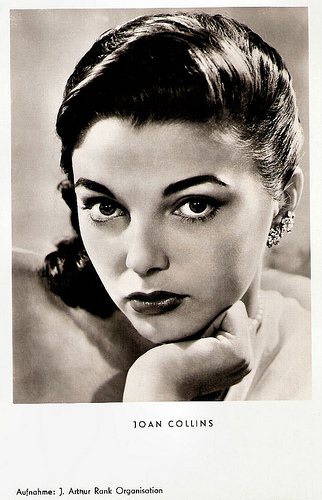
German postcard by Kunst und Bild, Berlin, no. A 773. Photo: J. Arthur Rank Organisation.
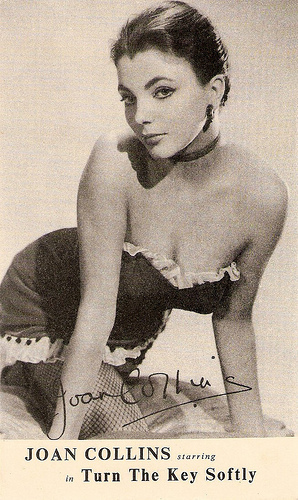
British collectors card. Publicity still for Turn The Key Softly (Jack Lee, 1953).
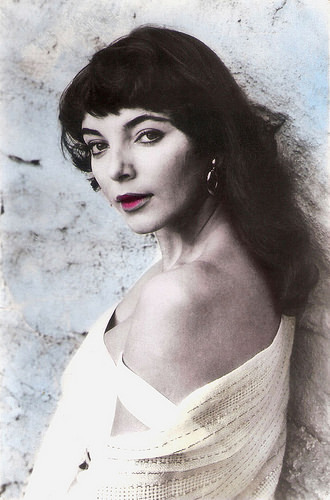
Yugoslavian postcard by Studio Sombor, Beograd, no. 160.
The British Open
Early, Joan Collins had developed a reputation for being adventurous and gamesome in her private life. In Hollywood she was affectionately known as ‘The British Open’ because of her liberal lifestyle.
She first married Irish actor Maxwell Reed in 1952, and the couple divorced in 1956. In 1959, she embarked on an affair with an as-then-unknown Warren Beatty, four years her junior, which would last for two years.
In 1963 she married actor Anthony Newley. They had two children, a daughter Tara Newley and a son, Alexander Newley. Collins and Newley divorced in 1970.
In 1972 she married her third husband Ron Kass, who had been the president of Apple Records when The Beatles reigned. During their marriage Collins had her third and final child, daughter Katyana Kass.
In 1981, Collins was offered a role in the then-struggling new prime time soap opera Dynasty (1981-1989) playing Alexis, the vengeful ex-wife of tycoon Blake Carrington (John Forsythe). The role successfully relaunched Collins as a powerful sex symbol and icon of independence.
Her performance is generally credited as one factor in the fledgling show's subsequent rise to a hit rivaling Dallas. In 1985, Dynasty was the #1 show in the U.S., and Collins became the highest-paid TV actress at the time.
As Alexis, Collins was nominated six times for a Golden Globe Award, winning once in 1983. Delighting the audience in attendance at the ceremony, Joan thanked Sophia Loren for turning down the part of Alexis.
Collins' marriage to Kass ended in divorce in 1983, although they remained very close until his death from cancer in 1986. At the height of Dynasty's popularity in 1985, Collins married Swedish singer Peter Holm. They were divorced two years later.
With Dynasty at the height of its success, Collins began producing and starred in two CBS miniseries, Sins (Douglas Hickox, 1986) with Timothy Dalton and Jean-Pierre Aumont , and Monte Carlo (Anthony Page, 1986) with George Hamilton.
She also appeared on the cover of and in a twelve-page layout shot by George Hurrell for Playboy magazine at the age of 49. She remained with Dynasty until its 1989 cancellation.
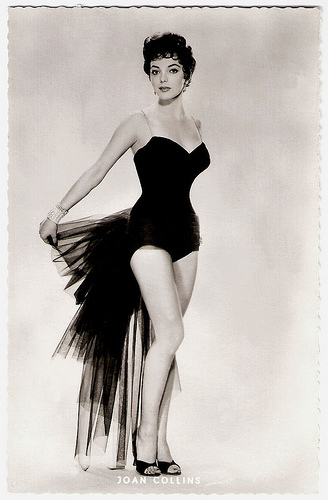
German postcard by Kunst und Bild, no. S 789. Photo: Metro-Goldwyn-Mayer. Publicity still for The Opposite Sex (1956) (David Miller, 1956).
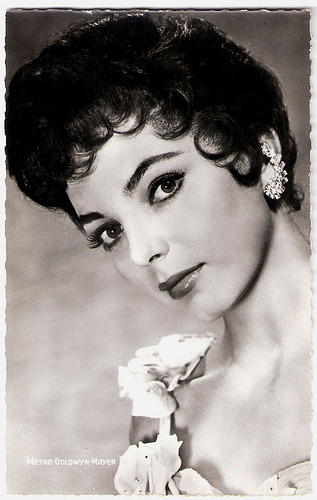
French postcard by Editions du Globe, no. 561. Photo: Metro-Goldwyn-Mayer / International Press.
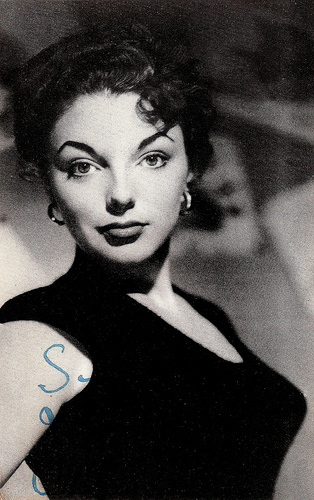
British postcard by L.D. LTD., London, in the Film Star Autograph Portrait Series, no. 60. Photo: J. Arthur Rank Organisation.
Pearl Slaghoople
Joan Collins left Los Angeles and returned to London where she lived with art dealer Robin Hurlstone for over a decade. In the 1990s she made several guest star appearances on TV series such as Roseanne (1993), The Nanny (1996) and Will & Grace (2000).
In the meantime she starred in British films like Decadence (Steven Berkoff, 1994) and In the Bleak Midwinter (Kenneth Branagh, 1995). In 1994 she launched her exercise video Joan Collins Personal Workout, at the age of 60.
She also appeared successfully in stage plays by Noel Coward. In 1990, she played Amanda in a revival of Coward's Private Lives in the West End. The following year she appeared in Coward's Tonight at 8:30 and played eight different women in a series of one-act plays written by Coward. In 1992, she made her Broadway debut in an adaptation of Coward's Private Lives.
She also appeared in films including The Flintstones in Viva Rock Vegas (Brian Levant, 2000) as Pearl Slaghoople, and the Dutch comedy Ellis in Glamourland/Alice in Glamourland (Pieter Kramer, 2004).
In 2002, Collins married theatrical company manager Percy Gibson, a man 32 years her junior. He directed her in An Evening With Joan Collins (2006), a one-woman show in which she detailed the highs and lows of her roller coaster career and life.
Joan Collins has also established herself as an author. In addition to her bestselling novels, including Prime Time, Love & Desire & Hate, Infamous, Star Quality, and Misfortune's Daughters, she has written five lifestyle books and memoirs. To date she has sold over 50 million copies of her novels which have been translated into 30 languages. She also writes occasionally columns for the Daily Mail, The Times, The Daily Telegraph, and Harper's Bazaar.
In 1997, Collins was granted the title of OBE (Officer of the Order of the British Empire) by Queen Elizabeth II in honour of her contribution to the arts and ongoing charity work.
Recently, Joan Collins appeared in the TV film Marple: They Do It with Mirrors (Andy Wilson, 2009) and the short film Fetish (Matthew J. Pellowski, 2010).
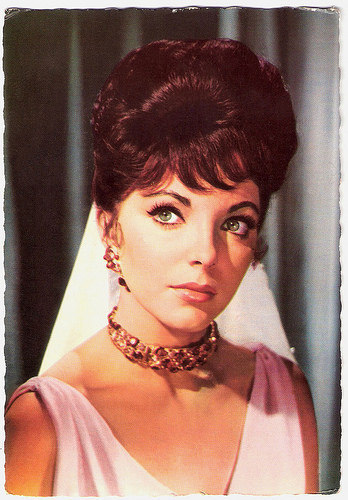
French postcard by E.D.U.G., no. 155.
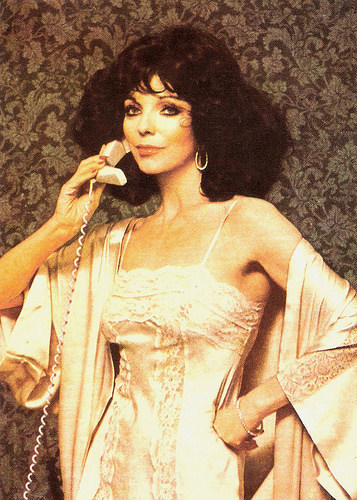
Romanian postcard by Casa Filmului Acin.
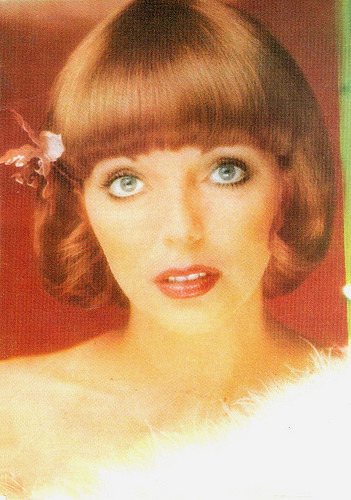
Romanian postcard by Casa Filmului Acin.
Trailer for Empire of the Ants (1977). Source: sideshowcarny (YouTube).
Sources: Hal Erickson (AllMovie), Wikipedia, and .

German postcard by FHAK.

Canadian postcard in the Fan Club Postcard Series, no. 2.

Italian postcard by Ed. Ris. Rotalfoto S.p.A., Milano (Milan) in the series Artisti di Sempre, no. 295.

German postcard.
Perennial Starlet
Joan Henrietta Collins was born in Paddington, London, in 1933 (some sources say 1931 or 1935). She was the daughter of Elsa (née Bessant), a dance teacher and nightclub hostess, and Joseph William Collins, an agent whose clients would later included Shirley Bassey, The Beatles and Tom Jones . She has one sister, the author Jackie Collins, and a brother, real estate agent Bill Collins.
Joan was educated at the Francis Holland School and then trained at the Royal Academy of Dramatic Art (RADA). In 1951, she made her feature debut in a small role as a beauty contestant in the comedy Lady Godiva Rides Again (Frank Launder, 1951). The next year she left RADA and starred in the crime drama Cosh Boy (Lewis Gilbert, 1952), and appeared as a juvenile delinquent in I Believe in You (Basil Dearden, Michael Relph, 1952).
The Rank Organisation then took an interest in Collins and gave her a contract. Rank set about moulding Joan into their idea of a well-groomed film star. They entrusted her to Cornel Lucas, their top stills photographer. Lucas, who was married to Belinda Lee at the time, produced the first really glamorous photographs of Joan. Collins was a popular magazine pin-up in the UK throughout the 1950s and into the 1960s.
The Rank Organisation also cast Joan in a succession of undistinguished films, plus the interesting thriller The Good Die Young (Lewis Gilbert, 1954) in which she starred opposite Laurence Harvey . Rank loaned her out to Howard Hawks, who was making Land Of The Pharaohs (1955) in Rome. Joan played the star role as a scheming, unscrupulous Egyptian Princess.
This assignment led to a contract with 20th Century-Fox, where despite a few good dramatic parts, in particular Girl on the Red Velvet Swing (Richard Fleischer, 1955) and the grim western The Bravados (Henry King, 1958), she was written off by critics as decorative but nothing more.
In the 1960s she was perilously close to ‘perennial starlet’ status, but she made notable guest appearances on American TV series as Batman (1967), Mission: Impossible (1969), and Star Trek (1967).
By the 1970s she was the uncrowned queen of European B-pictures like the thriller Revenge (Sidney Hayers, 1971), the SF-mystery Quest for Love (Ralph Thomas, 1971) and the horror film Dark Places (Don Sharp, 1973) with Christopher Lee.
Then she starred in the film versions of her sister Jackie Collins' racy novels The Stud (Quentin Masters, 1978) with Oliver Tobias, and The Bitch (Gerry O'Hara, 1979). Both films were smash hits in England, but also despised by the international critics.

German postcard by Kunst und Bild, Berlin, no. A 773. Photo: J. Arthur Rank Organisation.

British collectors card. Publicity still for Turn The Key Softly (Jack Lee, 1953).

Yugoslavian postcard by Studio Sombor, Beograd, no. 160.
The British Open
Early, Joan Collins had developed a reputation for being adventurous and gamesome in her private life. In Hollywood she was affectionately known as ‘The British Open’ because of her liberal lifestyle.
She first married Irish actor Maxwell Reed in 1952, and the couple divorced in 1956. In 1959, she embarked on an affair with an as-then-unknown Warren Beatty, four years her junior, which would last for two years.
In 1963 she married actor Anthony Newley. They had two children, a daughter Tara Newley and a son, Alexander Newley. Collins and Newley divorced in 1970.
In 1972 she married her third husband Ron Kass, who had been the president of Apple Records when The Beatles reigned. During their marriage Collins had her third and final child, daughter Katyana Kass.
In 1981, Collins was offered a role in the then-struggling new prime time soap opera Dynasty (1981-1989) playing Alexis, the vengeful ex-wife of tycoon Blake Carrington (John Forsythe). The role successfully relaunched Collins as a powerful sex symbol and icon of independence.
Her performance is generally credited as one factor in the fledgling show's subsequent rise to a hit rivaling Dallas. In 1985, Dynasty was the #1 show in the U.S., and Collins became the highest-paid TV actress at the time.
As Alexis, Collins was nominated six times for a Golden Globe Award, winning once in 1983. Delighting the audience in attendance at the ceremony, Joan thanked Sophia Loren for turning down the part of Alexis.
Collins' marriage to Kass ended in divorce in 1983, although they remained very close until his death from cancer in 1986. At the height of Dynasty's popularity in 1985, Collins married Swedish singer Peter Holm. They were divorced two years later.
With Dynasty at the height of its success, Collins began producing and starred in two CBS miniseries, Sins (Douglas Hickox, 1986) with Timothy Dalton and Jean-Pierre Aumont , and Monte Carlo (Anthony Page, 1986) with George Hamilton.
She also appeared on the cover of and in a twelve-page layout shot by George Hurrell for Playboy magazine at the age of 49. She remained with Dynasty until its 1989 cancellation.

German postcard by Kunst und Bild, no. S 789. Photo: Metro-Goldwyn-Mayer. Publicity still for The Opposite Sex (1956) (David Miller, 1956).

French postcard by Editions du Globe, no. 561. Photo: Metro-Goldwyn-Mayer / International Press.

British postcard by L.D. LTD., London, in the Film Star Autograph Portrait Series, no. 60. Photo: J. Arthur Rank Organisation.
Pearl Slaghoople
Joan Collins left Los Angeles and returned to London where she lived with art dealer Robin Hurlstone for over a decade. In the 1990s she made several guest star appearances on TV series such as Roseanne (1993), The Nanny (1996) and Will & Grace (2000).
In the meantime she starred in British films like Decadence (Steven Berkoff, 1994) and In the Bleak Midwinter (Kenneth Branagh, 1995). In 1994 she launched her exercise video Joan Collins Personal Workout, at the age of 60.
She also appeared successfully in stage plays by Noel Coward. In 1990, she played Amanda in a revival of Coward's Private Lives in the West End. The following year she appeared in Coward's Tonight at 8:30 and played eight different women in a series of one-act plays written by Coward. In 1992, she made her Broadway debut in an adaptation of Coward's Private Lives.
She also appeared in films including The Flintstones in Viva Rock Vegas (Brian Levant, 2000) as Pearl Slaghoople, and the Dutch comedy Ellis in Glamourland/Alice in Glamourland (Pieter Kramer, 2004).
In 2002, Collins married theatrical company manager Percy Gibson, a man 32 years her junior. He directed her in An Evening With Joan Collins (2006), a one-woman show in which she detailed the highs and lows of her roller coaster career and life.
Joan Collins has also established herself as an author. In addition to her bestselling novels, including Prime Time, Love & Desire & Hate, Infamous, Star Quality, and Misfortune's Daughters, she has written five lifestyle books and memoirs. To date she has sold over 50 million copies of her novels which have been translated into 30 languages. She also writes occasionally columns for the Daily Mail, The Times, The Daily Telegraph, and Harper's Bazaar.
In 1997, Collins was granted the title of OBE (Officer of the Order of the British Empire) by Queen Elizabeth II in honour of her contribution to the arts and ongoing charity work.
Recently, Joan Collins appeared in the TV film Marple: They Do It with Mirrors (Andy Wilson, 2009) and the short film Fetish (Matthew J. Pellowski, 2010).

French postcard by E.D.U.G., no. 155.

Romanian postcard by Casa Filmului Acin.

Romanian postcard by Casa Filmului Acin.
Trailer for Empire of the Ants (1977). Source: sideshowcarny (YouTube).
Sources: Hal Erickson (AllMovie), Wikipedia, and .
Published on September 14, 2014 23:00
September 13, 2014
Himmelskibet (1918)
This week's film special is about a silent Danish Science Fiction film about a trip to Mars! On the German postcards by Photochemie in this post, the film is called Das Himmelschiff, but the original Danish title is Himmelskibet. This translates as 'the airship', but the English release titles are A Trip to Mars and 400 Million Miles from Earth. Himmelskibet was made in 1918 by Holger-Madsen for the successful Nordisk Films Kompagni. The stars were Gunnar Tolnaes as space ship captain Avanti Planetaros, and Lilly Jacobsson as Marya, the Martian leader's daughter.
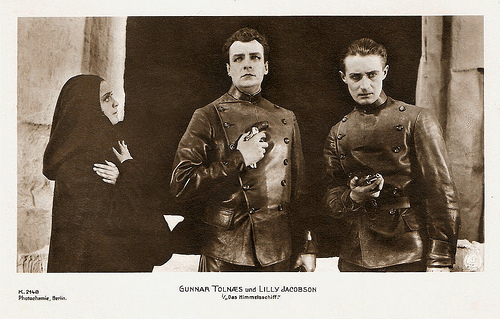
German postcard by Photochemie, Berlin, no. K. 2148. Photo: Nordisk. Publicity still for Himmelskibet/Das Himmelschiff (Holger-Madsen, 1918) with Lilly Jacobsson as Marya, Gunnar Tolnaes as Avanti Planetaros, and Alf Blütecher as his friend Dr. Krafft.
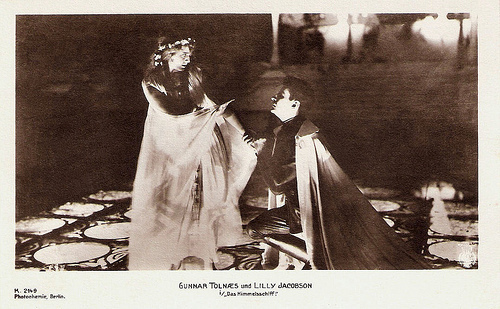
German postcard by Photochemie, Berlin, no. K. 2149. Photo: Nordisk. Publicity still for Himmelskibet/Das Himmelschiff (Holger-Madsen, 1918) with Lilly Jacobsson and Gunnar Tolnaes .
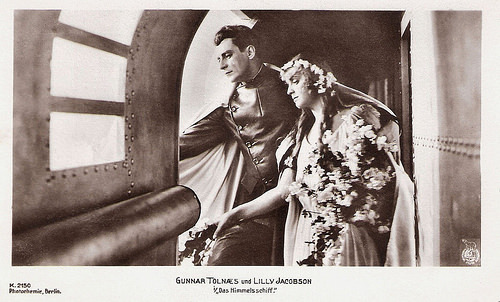
German postcard by Photochemie, Berlin, no. K. 2150. Photo: Nordisk. Publicity still for Himmelskibet/Das Himmelschiff (Holger-Madsen, 1918) with Lilly Jacobsson and Gunnar Tolnaes .
A Trip to Mars
Himmelskibet/A Trip to Mars (Holger Madsen, 1918) is one of the first Space Operas. The story was based on Sophus Michaëlis' novel Himmelskibet and adapted by the author himself and Ole Olsen. Frederik Fuglsang and Louis Larsen were the cinematographers. Production Designer was Carlo Jacobsen and Art Director Axel Bruun.
Himmelskibet concerns Captain Avanti Planetaros ( Gunnar Tolnaes ) and his trip with his space ship Excelsior to Mars. On Mars, Avanti finds a race of white-robed, mystic vegetarians, and he enlists the services of Marya ( Lilly Jacobsson ), the daughter of the local High Priest and leader (Philip Bech).
Among the cast are also Zanny Petersen as Corona, Avanti's Sister, Nicolai Neiiendam as their father, the Astronomer Professor Planetaros, Alf Blütecher as Avanti's Friend Dr. Krafft, and Nils Asther in an uncredited bit part as a Martian.
On Mars, Avanti converts to pacifism and returns to Earth to spread the message. Before long, peace breaks out all over the planet and a well-placed bolt of lightning quickly wipes out the only resistance to this creed.
Freeman Williams writes at his Bad Movie Report about the social context of the film, the first World War, in which the film was produced: "Himmelskibet was released in February of 1918, nine months before the cease fire with Germany was signed, which meant that for its entire shooting schedule, one of the most horrific wars yet seen was raging on with no signs of letting up. (...)
Given that, the tenor of the story is perfectly understandable, and Himmelskibet works better perhaps as a parable than it does as a science fiction or cautionary tale." Bad Movie Report rates the film as: 'Teetering on the brink of greatness. A good time' and adds 'Sweet movie. And save us, Space Hippies!'
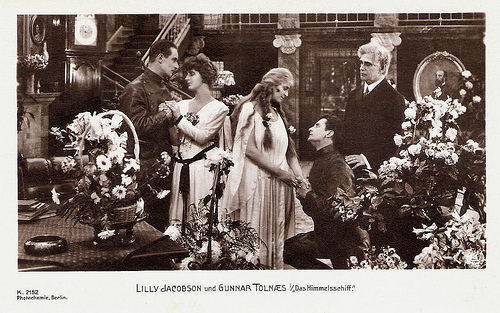
German postcard by Photochemie, Berlin, no. K. 2152. Photo: Nordisk. Still from Himmelskibet/Das Himmelschiff (Holger Madsen, 1918) with from left to right Alf Blütecher as Dr. Krafft, Zanny Petersen as Corona Planetaros, Lilly Jacobsson as Marya, Gunnar Tolnaes as Avanti Planetaros, and Nicolai Neiiendam as professor Planetaros, father of Corona and Avanti.
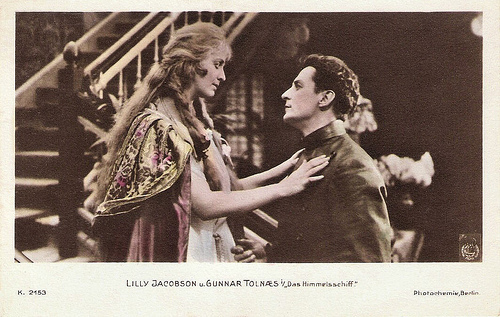
German postcard by Photochemie, Berlin, no. K. 2153. Photo: Nordisk. Still from Himmelskibet/Das Himmelschiff (Holger Madsen, 1918) with Lilly Jacobsson and Gunnar Tolnaes .
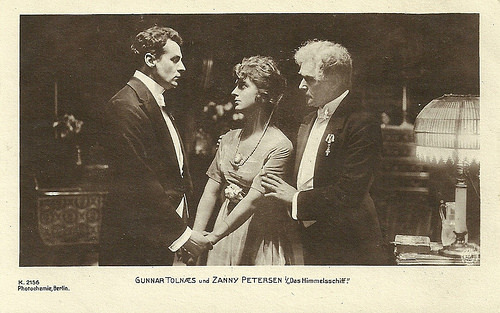
German postcard by Photochemie, Berlin, no. K. 2156. Photo: Nordisk. Publicity still for the science-fiction film Himmelskibet/Das Himmelschiff (Holger-Madsen, 1918) with Gunnar Tolnaes , as captain Avanti Planetaros, Zanny Petersen as his sister Corona, and Nicolai Neiiendam as their father, the astronomer professor Planetaros.
A True Oddity
Rhys Hughes at VideoVista rates Himmelskibet/A Trip to Mars (Holger-Madsen, 1918) among the Top 10 of Early Fantasy Films: "A true oddity this and a film that initially seems ahead of its time in many ways. (...)
Despite the flower power trappings, the beads and robes and consumption of lentils, Himmelskibet is really a reaction to the outbreak of WWI rather than an accurate prediction of the 1960s' alternative culture. Less surprisingly, perhaps, it stands alone as an example of early Danish fantasy cinema."
After Himmelskibet (1918), Denmark did not make another science fiction film until Reptilicus (Sidney W. Pink, 1962) starring Bent Mejding and Ann Smyrner .
Himmelskibet was believed to be by and large a lost film for many years, until the Det Danske Filminstitut (Danish Film Institute) located a fairly complete copy and set to restoring it. In 2006, nearly ninety years after its initial appearance, Himmelskibet (1918) was re-released on DVD by the Danish Film Institute.
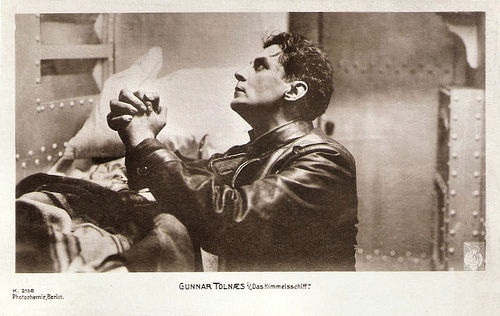
German postcard by Photochemie, Berlin, no. K. 2158. Photo: Nordisk. Publicity still for Himmelskibet/Das Himmelschiff (Holger-Madsen, 1918) with Gunnar Tolnaes .
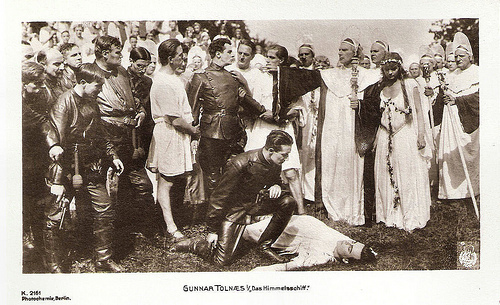
German postcard by Photochemie, Berlin, no. K. 2161. Photo: Nordisk. Publicity still for Himmelskibet/Das Himmelschiff (Holger-Madsen, 1918) with Gunnar Tolnaes as Avanti Planetaros, Philip Bech as the Martian leader, Lilly Jacobsson as Marya, the Martian leader's daughter, Alf Blütecher (kneeling) as Avanti Planetaros' friend Dr. Krafft and Nils Asther as the fallen Martian.
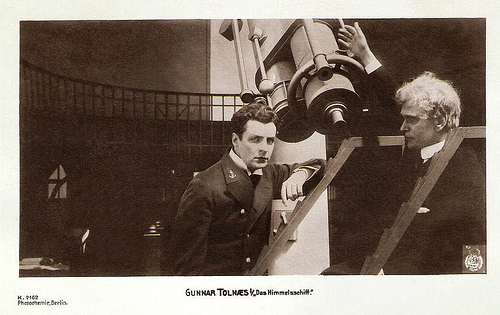
German postcard by Photochemie, Berlin, no. K. 2162. Photo: Nordisk. Publicity still for Himmelskibet/Das Himmelschiff (Holger-Madsen, 1918) with Gunnar Tolnaes as Avanti Planetaros and Nicolai Neiiendam as his father, the astronomer professor Planetaros.
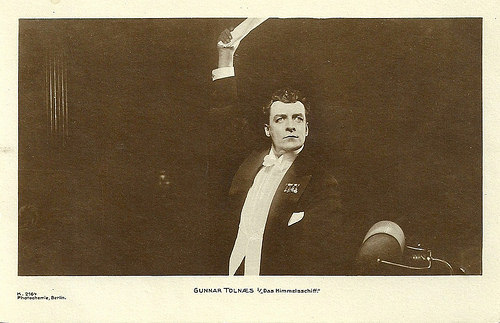
German postcard by Photochemie, Berlin, no. K. 2164. Photo: Nordisk. Publicity still for the science-fiction film Himmelskibet/Das Himmelschiff (Holger-Madsen, 1918) with Gunnar Tolnaes .
The restored Himmelskibet/A trip to Mars (1918). Source: Sebastian Castillo (YouTube).
Sources: Rhys Hughes (VideoVista), Freeman Williams (The Bad Movie Report), Wikipedia and IMDb.

German postcard by Photochemie, Berlin, no. K. 2148. Photo: Nordisk. Publicity still for Himmelskibet/Das Himmelschiff (Holger-Madsen, 1918) with Lilly Jacobsson as Marya, Gunnar Tolnaes as Avanti Planetaros, and Alf Blütecher as his friend Dr. Krafft.

German postcard by Photochemie, Berlin, no. K. 2149. Photo: Nordisk. Publicity still for Himmelskibet/Das Himmelschiff (Holger-Madsen, 1918) with Lilly Jacobsson and Gunnar Tolnaes .

German postcard by Photochemie, Berlin, no. K. 2150. Photo: Nordisk. Publicity still for Himmelskibet/Das Himmelschiff (Holger-Madsen, 1918) with Lilly Jacobsson and Gunnar Tolnaes .
A Trip to Mars
Himmelskibet/A Trip to Mars (Holger Madsen, 1918) is one of the first Space Operas. The story was based on Sophus Michaëlis' novel Himmelskibet and adapted by the author himself and Ole Olsen. Frederik Fuglsang and Louis Larsen were the cinematographers. Production Designer was Carlo Jacobsen and Art Director Axel Bruun.
Himmelskibet concerns Captain Avanti Planetaros ( Gunnar Tolnaes ) and his trip with his space ship Excelsior to Mars. On Mars, Avanti finds a race of white-robed, mystic vegetarians, and he enlists the services of Marya ( Lilly Jacobsson ), the daughter of the local High Priest and leader (Philip Bech).
Among the cast are also Zanny Petersen as Corona, Avanti's Sister, Nicolai Neiiendam as their father, the Astronomer Professor Planetaros, Alf Blütecher as Avanti's Friend Dr. Krafft, and Nils Asther in an uncredited bit part as a Martian.
On Mars, Avanti converts to pacifism and returns to Earth to spread the message. Before long, peace breaks out all over the planet and a well-placed bolt of lightning quickly wipes out the only resistance to this creed.
Freeman Williams writes at his Bad Movie Report about the social context of the film, the first World War, in which the film was produced: "Himmelskibet was released in February of 1918, nine months before the cease fire with Germany was signed, which meant that for its entire shooting schedule, one of the most horrific wars yet seen was raging on with no signs of letting up. (...)
Given that, the tenor of the story is perfectly understandable, and Himmelskibet works better perhaps as a parable than it does as a science fiction or cautionary tale." Bad Movie Report rates the film as: 'Teetering on the brink of greatness. A good time' and adds 'Sweet movie. And save us, Space Hippies!'

German postcard by Photochemie, Berlin, no. K. 2152. Photo: Nordisk. Still from Himmelskibet/Das Himmelschiff (Holger Madsen, 1918) with from left to right Alf Blütecher as Dr. Krafft, Zanny Petersen as Corona Planetaros, Lilly Jacobsson as Marya, Gunnar Tolnaes as Avanti Planetaros, and Nicolai Neiiendam as professor Planetaros, father of Corona and Avanti.

German postcard by Photochemie, Berlin, no. K. 2153. Photo: Nordisk. Still from Himmelskibet/Das Himmelschiff (Holger Madsen, 1918) with Lilly Jacobsson and Gunnar Tolnaes .

German postcard by Photochemie, Berlin, no. K. 2156. Photo: Nordisk. Publicity still for the science-fiction film Himmelskibet/Das Himmelschiff (Holger-Madsen, 1918) with Gunnar Tolnaes , as captain Avanti Planetaros, Zanny Petersen as his sister Corona, and Nicolai Neiiendam as their father, the astronomer professor Planetaros.
A True Oddity
Rhys Hughes at VideoVista rates Himmelskibet/A Trip to Mars (Holger-Madsen, 1918) among the Top 10 of Early Fantasy Films: "A true oddity this and a film that initially seems ahead of its time in many ways. (...)
Despite the flower power trappings, the beads and robes and consumption of lentils, Himmelskibet is really a reaction to the outbreak of WWI rather than an accurate prediction of the 1960s' alternative culture. Less surprisingly, perhaps, it stands alone as an example of early Danish fantasy cinema."
After Himmelskibet (1918), Denmark did not make another science fiction film until Reptilicus (Sidney W. Pink, 1962) starring Bent Mejding and Ann Smyrner .
Himmelskibet was believed to be by and large a lost film for many years, until the Det Danske Filminstitut (Danish Film Institute) located a fairly complete copy and set to restoring it. In 2006, nearly ninety years after its initial appearance, Himmelskibet (1918) was re-released on DVD by the Danish Film Institute.

German postcard by Photochemie, Berlin, no. K. 2158. Photo: Nordisk. Publicity still for Himmelskibet/Das Himmelschiff (Holger-Madsen, 1918) with Gunnar Tolnaes .

German postcard by Photochemie, Berlin, no. K. 2161. Photo: Nordisk. Publicity still for Himmelskibet/Das Himmelschiff (Holger-Madsen, 1918) with Gunnar Tolnaes as Avanti Planetaros, Philip Bech as the Martian leader, Lilly Jacobsson as Marya, the Martian leader's daughter, Alf Blütecher (kneeling) as Avanti Planetaros' friend Dr. Krafft and Nils Asther as the fallen Martian.

German postcard by Photochemie, Berlin, no. K. 2162. Photo: Nordisk. Publicity still for Himmelskibet/Das Himmelschiff (Holger-Madsen, 1918) with Gunnar Tolnaes as Avanti Planetaros and Nicolai Neiiendam as his father, the astronomer professor Planetaros.

German postcard by Photochemie, Berlin, no. K. 2164. Photo: Nordisk. Publicity still for the science-fiction film Himmelskibet/Das Himmelschiff (Holger-Madsen, 1918) with Gunnar Tolnaes .
The restored Himmelskibet/A trip to Mars (1918). Source: Sebastian Castillo (YouTube).
Sources: Rhys Hughes (VideoVista), Freeman Williams (The Bad Movie Report), Wikipedia and IMDb.
Published on September 13, 2014 23:00
September 12, 2014
New acquisitions Geoffrey Donaldson Institute
Last year, the Geoffrey Donaldson Instituut (GDI) in Noord-Scharwoude, the Netherlands, opened its doors. The GDI promotes research of film production, film screening and film culture in the Netherlands. At the moment, you can visit a small, delightful exhibition 'Bert Haanstra - schilder, tekenaar, fotograaf', about the Oscar winning Dutch director (on view till 16 October 2014). GDI also produced a beautiful new book on Haanstra, written by Hans Schoots. Chairman of the board of GDI is film historian Egbert Barten, whose postcard collection is permanently on view at EFSP. Today, a choice from his latest postcard acquisitions.
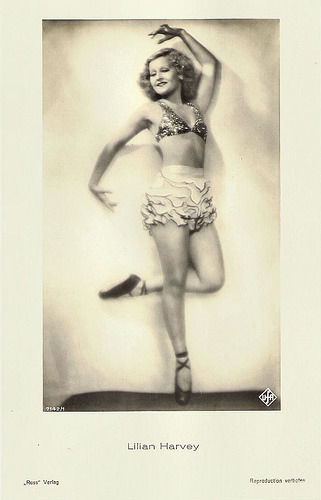
Lilian Harvey . German postcard by Ross Verlag, no. 7142/1, 1932-1933. Photo: Ufa. Collection: Egbert Barten.
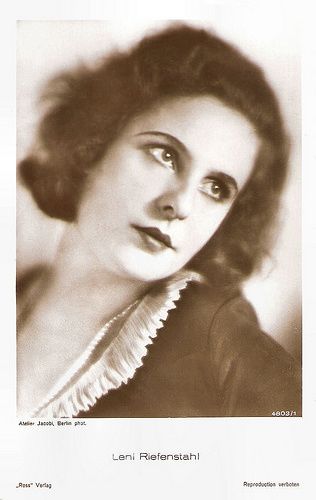
Leni Riefenstahl . German postcard by Ross Verlag, no. 4803/1, 1929-1930. Photo: Atelier Jacobi, Berlin. Collection: Egbert Barten.
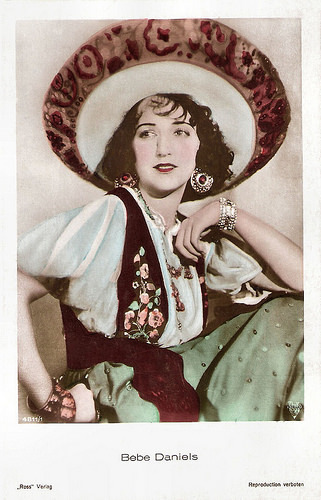
Bebe Daniels. German postcard by Ross Verlag, no. 4811/1, 1929-1930. Photo: RKO Radio Pictures. Collection: Egbert Barten.
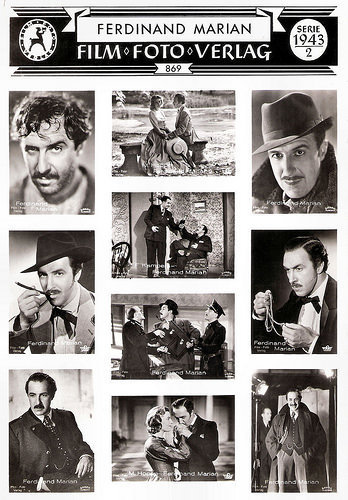
Ferdinand Marian . German serie-card by Film-Foto-Verlag, no. 869, series, no 2, 1943. Collection: Egbert Barten.
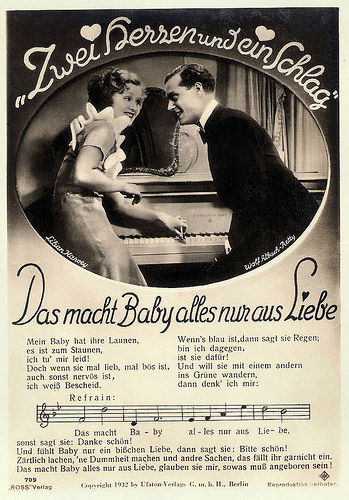
Lilian Harvey and Wolf Albach-Retty in Zwei Herzen und ein Schlag (1932). German postcard by Ross Verlag, no. 709. Photo: Ufa. Publicity still for Zwei Herzen und ein Schlag/Two Hearts Beat as One (Wilhelm Thiele, 1932). Collection: Egbert Barten.
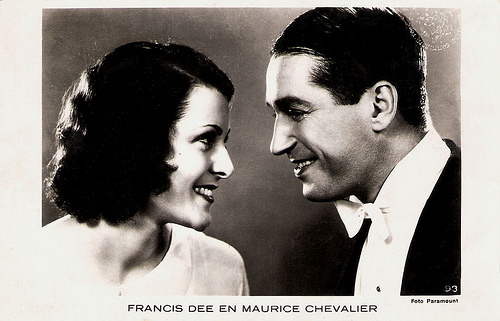
Frances Dee and Maurice Chevalier in The Playboy of Paris (1930). Dutch postcard, no. 93, Photo: Paramount. Publicity still for The Playboy of Paris (Ludwig Berger, 1930). Collection: Egbert Barten.
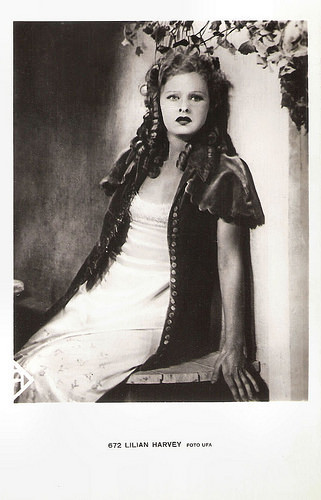
Lilian Harvey . Dutch postcard, no. 672. Photo: Ufa. Collection: Egbert Barten.
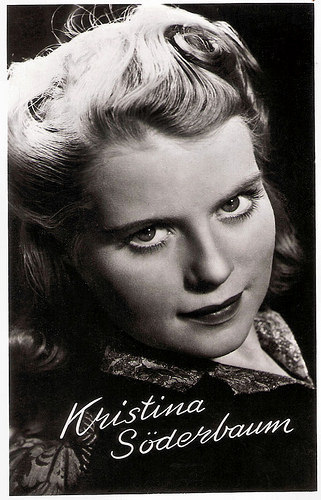
Kristina Söderbaum . Dutch postcard. Collection: Egbert Barten.
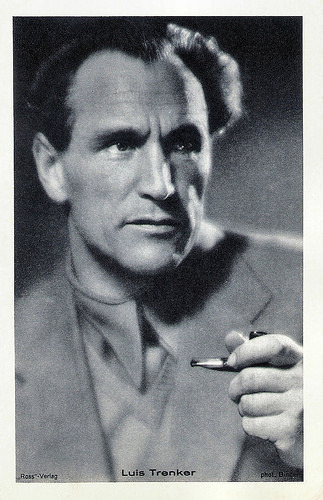
Luis Trenker . German postcard by Ross-Verlag. Photo: Binder. Collection: Egbert Barten.
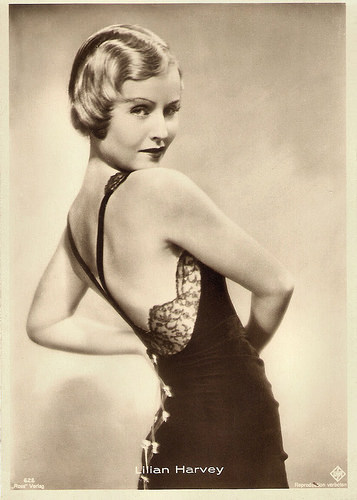
Lilian Harvey . German postcard by Ross Verlag, no. 628. Photo: Ufa. Collection: Egbert Barten.
Source: Geoffrey Donaldson Institute (Dutch).

Lilian Harvey . German postcard by Ross Verlag, no. 7142/1, 1932-1933. Photo: Ufa. Collection: Egbert Barten.

Leni Riefenstahl . German postcard by Ross Verlag, no. 4803/1, 1929-1930. Photo: Atelier Jacobi, Berlin. Collection: Egbert Barten.

Bebe Daniels. German postcard by Ross Verlag, no. 4811/1, 1929-1930. Photo: RKO Radio Pictures. Collection: Egbert Barten.

Ferdinand Marian . German serie-card by Film-Foto-Verlag, no. 869, series, no 2, 1943. Collection: Egbert Barten.

Lilian Harvey and Wolf Albach-Retty in Zwei Herzen und ein Schlag (1932). German postcard by Ross Verlag, no. 709. Photo: Ufa. Publicity still for Zwei Herzen und ein Schlag/Two Hearts Beat as One (Wilhelm Thiele, 1932). Collection: Egbert Barten.

Frances Dee and Maurice Chevalier in The Playboy of Paris (1930). Dutch postcard, no. 93, Photo: Paramount. Publicity still for The Playboy of Paris (Ludwig Berger, 1930). Collection: Egbert Barten.

Lilian Harvey . Dutch postcard, no. 672. Photo: Ufa. Collection: Egbert Barten.

Kristina Söderbaum . Dutch postcard. Collection: Egbert Barten.

Luis Trenker . German postcard by Ross-Verlag. Photo: Binder. Collection: Egbert Barten.

Lilian Harvey . German postcard by Ross Verlag, no. 628. Photo: Ufa. Collection: Egbert Barten.
Source: Geoffrey Donaldson Institute (Dutch).
Published on September 12, 2014 23:00
Paul van Yperen's Blog
- Paul van Yperen's profile
- 13 followers
Paul van Yperen isn't a Goodreads Author
(yet),
but they
do have a blog,
so here are some recent posts imported from
their feed.



